Creating Content to Drive Your Buyer Persona Down the Multifamily Marketing Funnel
In today’s competitive landscape, content marketing reigns supreme. While everyone acknowledges the power of content, its true potential is unleashed only when there’s unwavering consistency behind every piece of content created. Companies that are dedicated to producing high-quality, steady content capture attention and often outpace their competitors in terms of leads generated and website traffic. Yet, maintaining this consistency in content creation remains a daunting challenge for many businesses.
An effective content marketing plan, fortified with a well-thought-out content calendar, serves as a roadmap to success. This plan allows you to forge stronger connections with potential customers and ensures that you address their pain points at every stage of the buyer’s journey. With such a strategy, your organization can solidify its reputation as a trusted, valuable resource in the industry.

Why is a content marketing plan important?
The digital age has transformed how consumers engage with product or service providers. The once-dominant traditional methods of multifamily marketing are now receding into the background. They’re being replaced by dynamic marketing campaigns that leverage blog posts, social media marketing, and other digital strategies. These campaigns aim to tap into the ever-evolving needs of potential customers, guiding them step by step toward making a purchase decision.
Imagine casually browsing social media and stumbling upon a blog post about a product or service you’ve considered. If this content resonates with your needs and is followed up with more relevant content addressing your specific pain points, wouldn’t you be more inclined to explore further? This exemplifies the power of consistent and relevant content in drawing potential customers closer to your brand.
Now, picture your favorite actor, known for stellar performances in your cherished movies. If they consistently choose roles that strike a chord with you, over time, their mere involvement in a project would pique your interest. Similarly, businesses should aim to be that actor for their customers — always reliable, always delivering quality.
To achieve this, businesses need a well-defined content marketing plan. It’s crucial to involve product development, sales teams, and tools like Google Analytics to understand what content appeals most to your audience. Incorporate keyword research to ensure your content ranks well and garners attention. And, of course, every blog post, social media update, or marketing piece should conclude with compelling calls to action, guiding readers to the next step in their journey with your multifamily brand.
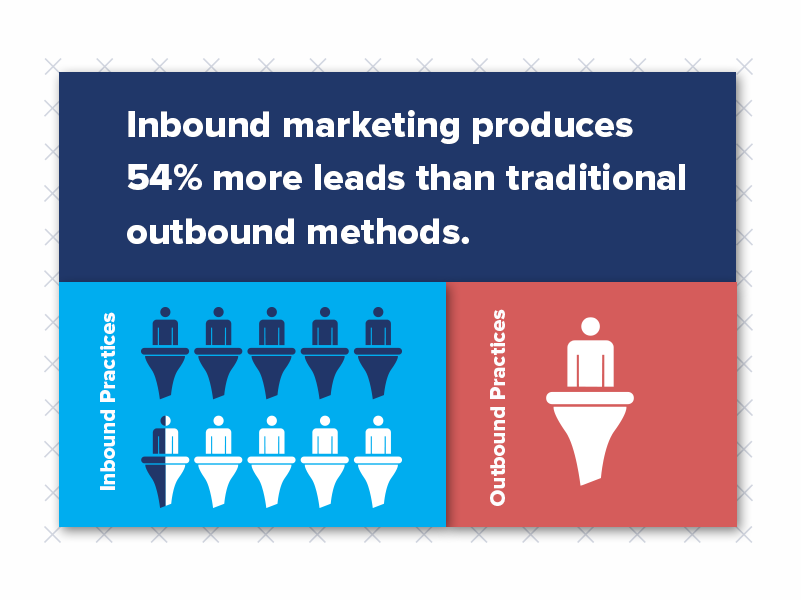
1. Understand and develop a buyer persona
As the foundation of effective marketing plans, understanding and creating a detailed buyer persona is the cornerstone for any successful content marketing strategy. This persona is not just a vague concept but a dynamic representation of your ideal customer, tailored for your specific product or service.
A buyer persona, according to HubSpot, is akin to a semi-fictional character. This character mirrors your prime audience’s aspirations, pain points, behavioral tendencies, and motivations. The key to producing high-quality and relevant content lies in your grasp of these personas. By tuning into their specific needs and addressing their distinct pain points through each piece of content, you can create compelling blog posts, social media marketing campaigns, and other types of content that resonate deeply with potential customers.
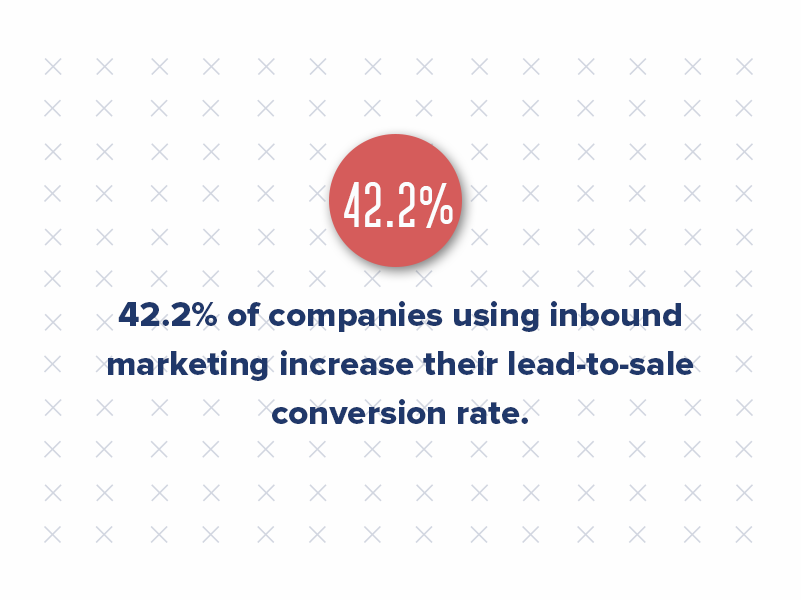
But how do you embark on this journey of buyer persona development? Begin step by step. Start by diving deep into the insights and data from your existing audience. Conducting in-depth interviews, preferably three to five, can provide a wealth of information. These interactions can spotlight trends, preferences, and unique attributes that define your persona.
Don’t stop there. Your sales team is an invaluable reservoir of insights. Integrating data from your CRM and collaborating closely with your sales team can create a more holistic view of your target demographic. Tools like Google Analytics can further refine this view, offering data-driven insights into website traffic and the success of specific pieces of content.
Once you’ve sculpted a clear buyer persona, it’s not a ‘set it and forget it’ task. As market dynamics shift and product development evolves, the needs and interests of your audience might also transform. Regularly revisiting, reassessing, and fine-tuning your personas, fortified with keyword research and calls to action, ensures your marketing campaigns remain fresh, relevant, and impactful.
2. Understand the buyer’s journey
Now that you have your buyer persona, you can better understand the buyer’s journey. According to HubSpot, “The buyer’s journey is the process buyers go through to become aware of, evaluate, and purchase a new product or service.”
- Awareness — Your persona has identified a problem and is trying to understand that problem.
- Consideration — Your persona is considering all potential solutions to alleviate their problem.
- Decision— Your persona is choosing a specific option to solve their problem.
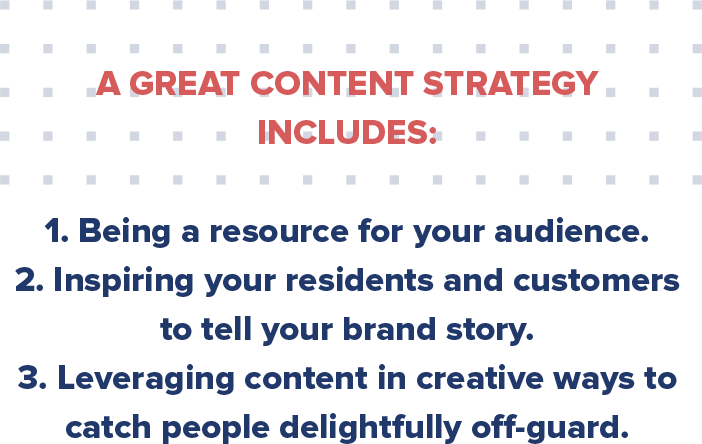
3. Using inbound multifamily marketing to guide your content
The solution to consistency is inbound multifamily marketing, a modern method that equips you to create content that drives buyer personas through your marketing funnel. This methodology will help guide your content marketing plan, expanding the awareness, consideration, and decision stages into four more specific stages: attract, convert, close, and delight.
Attract
The attract stage is about building awareness and creating content that turns strangers into visitors. Thus, you should primarily focus on blogs, social media, and white pages. The goal is to provide solutions to your persona’s problems.
Convert
This stage is about converting visitors into multifamily leads. The type of content you are producing would be in the form of a call-to-action (CTA) or landing page. Create gated offers where viewers must provide minimal information valuable to your business (email, zip code, etc.). For example, offers include infographics, fact sheets, eBooks, and how-to guides.
Close
In the close stage, your strategy should be all about turning leads into customers. In this stage, you should focus on your CRM, email, and workflows. It’s important to speak their language, meet their needs, and seal the deal.
Delight
In the delight stage, you will continue to provide value and show you care about your customers. In turn, they will become advocates and promoters for your business. Through social monitoring and surveys, you can see how satisfied your residents are; if there is a problem, you can address it quickly. Happy customers are your best advocates for attracting new leads.
Unlocking Success with Targeted Content Marketing
Recognizing the intricate nuances of these stages is pivotal for a successful marketing plan. By harnessing the power of content creation, you can navigate these phases with precision, ensuring your multifamily marketing campaigns align perfectly with your audience’s evolving needs. This systematic, step-by-step approach enhances the relevancy of each piece of content and amplifies its impact.
Ultimately, crafting the ideal material for the right context will position you as an authoritative figure in your industry, driving leads and fostering lasting relationships.

Leveraging Demographics for Building an Effective Multifamily Marketing Strategy
Multifamily marketing is not just about promoting products and services; it’s about connecting with your audience. And to do that, you need to understand who your audience is.
Demographic marketing is tailoring your multifamily marketing efforts to specific groups of people based on age, gender, income, education level, and other characteristics. When you understand your audience, you can create campaigns that resonate with them, speak their language, and address their specific needs and desires. In this era of information overload, it’s more important than ever to cut through the noise and grab the attention of your demographic target market.
Demographic marketing is a powerful tool that can help you do just that. By understanding who your audience is and what they want, you can create campaigns that are not only effective but also memorable and engaging.
So let’s take a closer look at the art of demographic marketing and how you can use it to connect with your audience and drive business success.
Understanding Your Demographic Target Market
Understanding your audience is critical to the success of your property marketing campaigns. You need to know your target audience, what they want, and what motivates them. Demographic marketing allows you to create campaigns that speak directly to your audience and address their needs and desires. The more you know about your audience, the better you can tailor your campaigns to them.
Demographic marketing can also help you identify new opportunities. Analyzing data allows you to identify trends and patterns that may not be immediately apparent. For example, you may discover that a particular demographic target market is underserved in your industry and create a campaign specifically targeting that group.
Ultimately, understanding your audience helps you create more effective campaigns. When you know your audience, you can create messaging that resonates with them, choose the right multifamily marketing channels, and optimize your campaigns for maximum impact.
Gathering Data on Your Target Audience
The first step in demographic marketing is to gather data on your audience. There are many ways to do this, including surveys, interviews, focus groups, and online research. The key is to gather as much data as possible to get a comprehensive understanding of your audience.
One of the most effective ways to gather data is through surveys. Surveys allow you to ask specific questions and get quantitative data to analyze. You can also use surveys to gather qualitative data by asking open-ended questions and allowing respondents to provide detailed responses.
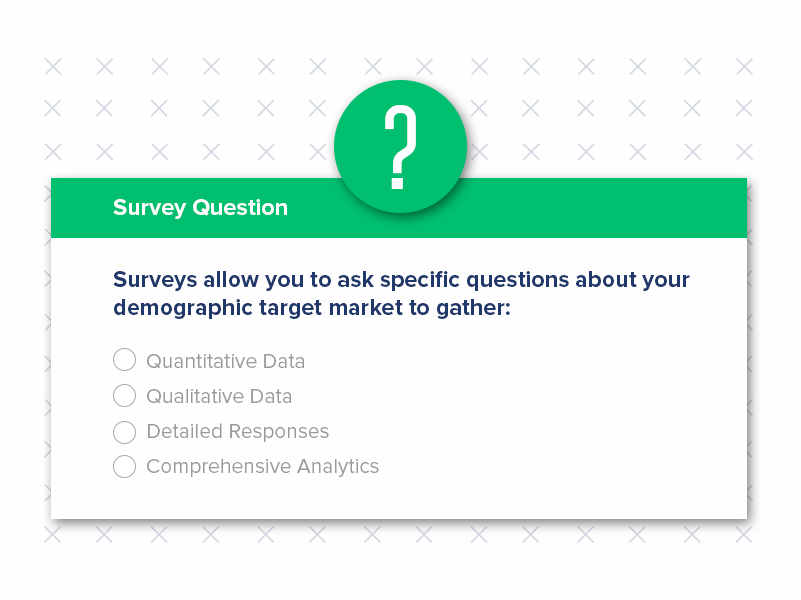
Another way to gather data is through online research. Many online tools and resources allow you to gather multifamily marketing data on your demographic target market. For example, you can use Google Analytics to gather data on your website visitors, including their age, gender, and location.
Analyzing and Interpreting Demographic Data
Once you have gathered data on your target audience, the next step is to analyze and interpret that data. This involves looking for patterns and trends that can help you understand your audience better.
One way to analyze data is to create charts and graphs to help you identify trends and patterns that may not be immediately apparent when looking at raw data. For example, you may discover that a particular age group is more likely to rent at your properties than others or that people with higher income levels are more likely to use your services than those with lower income levels.
Let’s take a closer look at each demographic group you’ll want to analyze:
1. Gender
Women and men think and react differently to certain things, but even more base level, they use the internet entirely differently. While men have gradually caught up with women in overall social media usage, there are differences in platform usage.
Women are likelier to spend time on Facebook, Pinterest, or Instagram, while men prefer forum-based social channels like Reddit. In e-commerce, men and women differ in how they search, with men searching by product while women searching by brand.
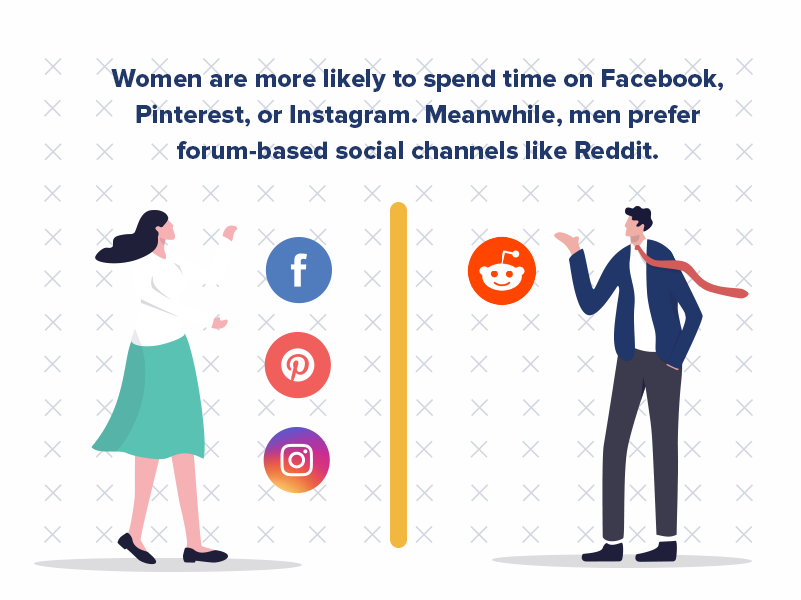
Knowing these key differences in usage patterns can greatly alter your marketing strategy. Targeting moms? Place ads on Facebook and post on Pinterest. Going after single young men? Post your blogs to a relevant subreddit.
2. Age
Baby boomers are online, but not to the extent of younger generations, and certainly not in the same places. Only 57% of Americans 65+ are online, as opposed to 93% of adults aged 30-49. Boomers and older Americans spend the most time checking their email. Meanwhile, younger generations split their time between social media, shopping online, and researching products.
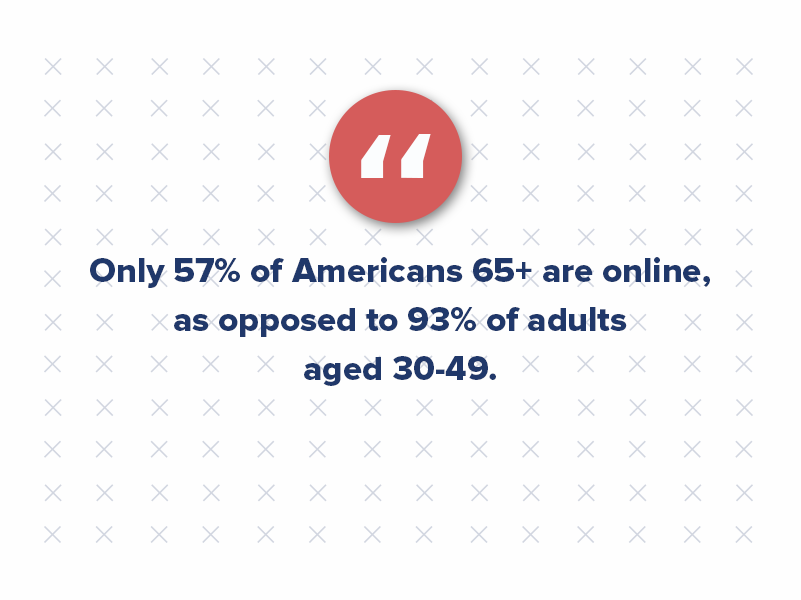
Keeping that in mind, a boomer seeking an active adult community might appreciate a newsletter on your offerings. A millennial seeking high-rise living might prefer a tweet.
3. Income
While internet browsing gaps between people of different incomes have narrowed, this information is still important for marketers. If you’re offering a tiered service, this data can help you better target the appropriate range to the appropriate person.
Why is this important? Because you wouldn’t want to alienate a customer who thinks a product may be out of their price range when they see the higher-end price.
4. Location
This can mean country, region, or even if someone is living in an urban or rural environment. While country and lifestyle have some effect on internet usage, the reason this multifamily marketing demographic is most important has much more to do with knowing and understanding your market.
Someone in an urban environment probably won’t need an industrial-grade sitting lawnmower. Likewise, people in New York City probably don’t want to see information about car accessories. Knowing a person’s location can also help ensure that any written content sent to them matches terms to their colloquial knowledge.
For example, using “pop” vs. “soda” or “coke” depending on where in the U.S. you’re from or ensuring that they’re not seeing deals that don’t pertain to them at their location (e.g., some insurance companies don’t operate in every state).
So, you’ve gathered your basic marketing demographics and are ready to start building your multifamily marketing strategy…
Hold up a second.
There’s more to it than that. While all this information is certainly a starting point, it’s important to take it deeper. In digital multifamily marketing, we call the amalgamation of this information a buyer persona — the typical person who might engage with your product.
Creating Buyer Personas
One of the most effective ways to use demographic data is to create buyer personas. Buyer personas are fictional representations of your ideal customers based on demographic data, behavior patterns, motivations, and goals.
Creating buyer personas helps you understand your audience better and create campaigns that resonate with them. For example, if you discover that a significant portion of your audience comprises millennials, you can create a buyer persona representing a typical millennial customer. This persona can guide your messaging, multifamily marketing channels, and campaign optimization.
Crafting Targeted Messaging
Once you have created buyer personas, the next step is to craft targeted messaging that speaks directly to your audience. This involves using language and imagery that resonates with your audience and addresses their needs and desires.
For example, if your audience is primarily women, you may want to use language and imagery that is more feminine in your campaigns. You may also want to focus on topics more relevant to women, such as health and wellness.
Targeted messaging can also help you stand out from your competitors. By crafting messages that speak directly to your audience, you can differentiate yourself from other brands and create a stronger connection with your customers.
Choosing the Right Marketing Channels
Different demographic groups may respond better to different multifamily marketing channels, so choosing the most effective for your target audience is important.
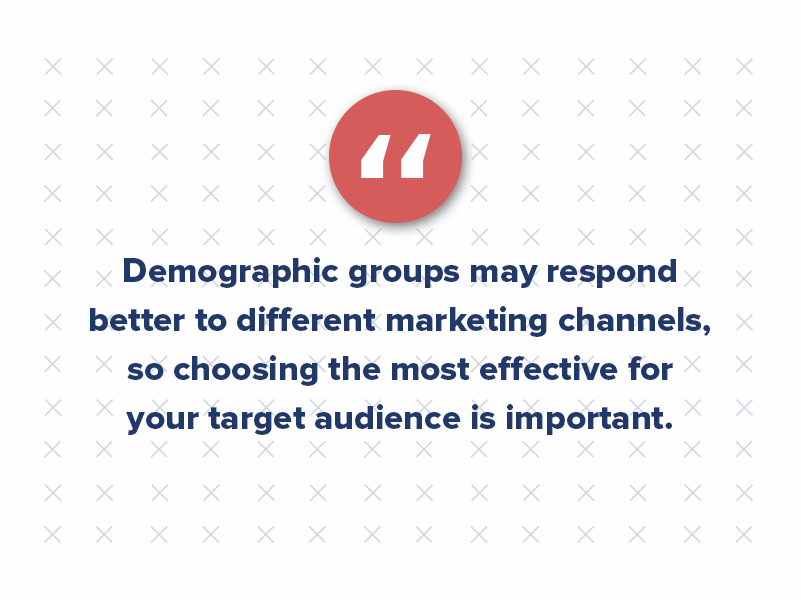
For example, if your target audience is primarily millennials and Gen Z, you may want to focus on social media marketing as they are more likely to use social media than other age groups.
You may also want to consider other marketing channels, such as email marketing, content marketing, and influencer marketing. The key is choosing the most effective channels for your target audience and aligning them with your overall marketing strategy.
Testing and Optimizing Your Campaigns
Testing and optimizing your campaigns is critical to their success. This involves continually monitoring and adjusting your campaigns based on their performance.
One way to test and optimize your campaigns is to use A/B testing. A/B testing involves creating two versions of your campaign and testing them against each other to see which performs better. This can help you identify the most effective messaging, design, or marketing channel for your target audience.
You can also use data analysis to optimize your campaigns. By continually monitoring your campaigns and analyzing the data, you can identify areas for improvement and make adjustments to improve their performance.
Common Mistakes to Avoid in Demographic Marketing
There are several common mistakes to avoid when it comes to demographic marketing. One of the most significant mistakes is assuming that all members of a particular demographic group are the same. This can lead to too broad campaigns that don’t speak directly to your audience.
Another mistake is relying too heavily on demographic data. While demographic data is critical to understanding your audience, it’s important to remember that individuals are complex and multifaceted. When crafting your campaigns, you need to consider other factors, such as behavior patterns and motivations.
Tools and Resources for Demographic Marketing
There are many tools and resources available to help you with demographic marketing. Social media platforms like Facebook and Instagram allow you to target specific demographic groups with your ads. Google Analytics provides valuable data on your website visitors, including their age, gender, and location.
You can also use market research and data analytics companies to gather and analyze data on your target audience. These companies can provide insights and recommendations to help you create more effective campaigns.
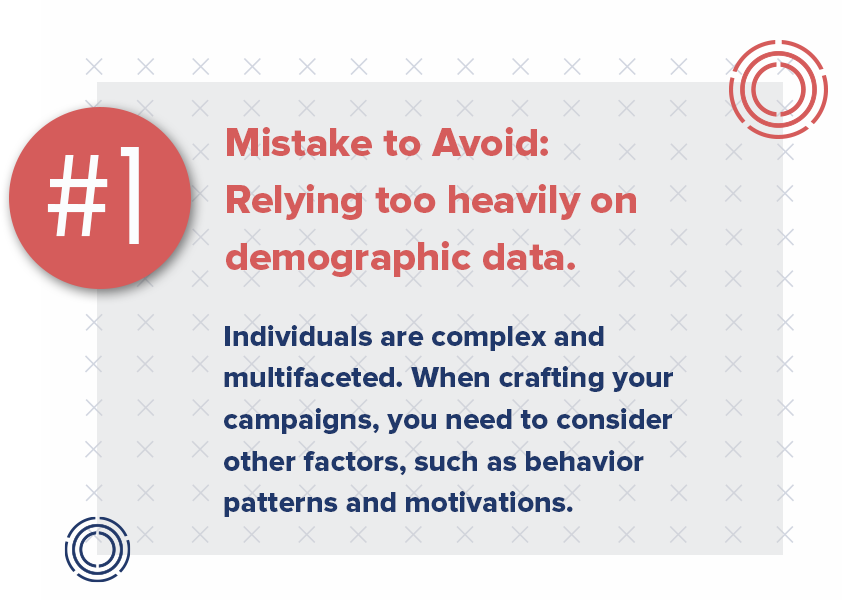
Driving Business Success With Demographic Marketing
Demographic marketing is a powerful tool to help you connect with your audience and drive business success. By understanding your audience and tailoring your campaigns to their specific needs and desires, you can create messaging that resonates with them and stands out from your competitors.
Remember to gather as much data as possible and create buyer personas, then continually test and optimize your campaigns. With these strategies, you can create campaigns that are not only effective but also memorable and engaging.
The Dynamic Duo: Creating Content Magic With ChatGPT and Our Content Marketing Agency
Digital content marketing can be challenging, especially when you have many other operations tasks. Enter Open AI ChatGPT.
The ChatGPT app has revolutionized digital content marketing and how we handle content writing, editing, and multifamily graphic design.

The biggest concerns surrounding this new artificial intelligence feature are: “How does ChatGPT work?” “What are good ChatGPT prompts?” and “Do I still need to hire a content marketing agency?”
Let’s answer each of these questions…
The Future of Generative AI in Property Management Marketing
Much like the shift to digital content marketing in recent years, the rise of generative AI has been slow but steady. And just in the last year, it has BOOMED.
Many industries are still coming aboard the realm of inbound marketing but not quite utilizing generative AI. However, Open AI ChatGPT will be key to becoming more efficient with your content marketing to stand out.
Effective content will help you embrace the feedback loop that allows your content to grow and develop. Only then will your content reach your targeting goals and give you the results you’re aiming for.
Understanding the Value of Generative AI
Before we can dive into how to use open source AI and answer “How does ChatGPT work?” we first need to discuss the benefits of using Open AI.
Generative AI provides marketers a powerful tool to streamline content creation processes and drive engagement. Ultimately, it allows marketers to quickly create large volumes of high-quality content, saving time and effort.
This technology offers fresh perspectives and innovative ideas, sparking creativity and enabling marketers to explore new angles in their content strategies. Moreover, this AI writing tool can optimize content for search engines, enhancing organic visibility and driving website traffic.

How Does ChatGPT Work?
ChatGPT operates on a sophisticated deep-learning model known as a transformer. This model is trained on vast text data to develop a deep understanding of language patterns and structures.
When a user provides ChatGPT prompts, the model analyzes the context and generates a response based on learned knowledge. It breaks down the ChatGPT prompts into segments, attends to the relevant parts, and generates a coherent output.
The training process involves exposing the model to a massive dataset that includes diverse sources such as books, articles, websites, and more. This exposure enables the writing tool to learn grammar, facts, reasoning abilities, and even some degree of creativity. The ChatGPT app gradually improves its ability to generate human-like responses through this iterative training process.
It’s important to note that while open source AI can produce impressive outputs, it should be used with caution and human oversight to ensure accuracy and maintain ethical standards.
And full disclosure: The AI writing tool wrote the above section about “How does ChatGPT work?”. Why? Because who knows ChatGPT better than the generative AI platform itself? This is exactly what we mean by supplementing your AI content with human oversight: no one knows your business like you do (or your content marketing agency).
How to Use ChatGPT
When utilizing open source AI for your digital content marketing, it’s important to understand how to leverage its capabilities effectively.
1. Use Open AI as a jumping-off tool to generate ideas.
Open source AI is best used to help kickstart your writing process, not execute the entire writing process. Provide clear and specific prompts to guide the AI in generating relevant content. ChatGPT’s output should be a starting point rather than a final piece.
2. Review all generative AI content for accuracy.
Maintain a critical eye and thoroughly review the generated content for accuracy, tone, and consistency with your brand voice. Make necessary edits and additions to ensure the content aligns with your objectives and resonates with your target audience.
3. Utilize open source AI for keyword research and optimization.
Extract valuable insights from the AI-generated content to identify relevant keywords and phrases that can enhance your search engine rankings.
4. Bring human writers and editors into the process.
Embrace the collaborative nature of the ChatGPT app by involving human writers and editors who can infuse creativity, authenticity, and expert knowledge into the content. By combining the power of AI writing with human expertise, you can create compelling and high-quality content that drives results in your digital content marketing efforts.
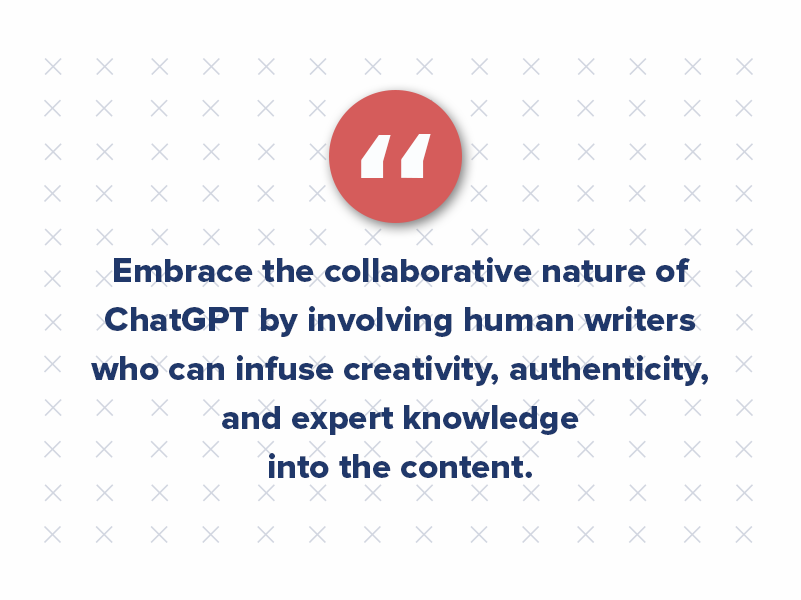
Use Humanized Content to Develop High-Performing Results
Have you ever received an email with your name in the subject line or a newsletter closely tied to a topic you’d been researching? That’s a form of content intelligence. The epitome of content intelligence is the ability to take names or other information gathered about prospects and use that information to enhance content.
Imagine being a decision-maker at a multifamily property interested in a third-party vendor company’s services. Wouldn’t that level of personalization, paired with an email that answers your questions, sway your decision to hire that company at your property?
Studies show that personalized messages can increase email open rates (17.6% open rate vs. 11.4% without personalization). This allows for more information to be gathered and improves your results. It’s a cyclical and powerful process.
The most important thing is to ensure you’re utilizing all the right tools to inform your content. While you can provide ChatGPT prompts to include personalization in the AI-generated content output, the bottom line is that Open AI ChatGPT does not know your brand as you do. And, as mentioned above, it also doesn’t know your customers like you do. Take advantage of this knowledge and personalize your content for the best results.
What Are Good ChatGPT Prompts?
ChatGPT prompts are specific and provide sufficient context for the desired output. They should be framed as questions, statements, or instructions that guide the AI’s response in a targeted manner.
You want to treat this AI writing platform like an intern, providing clear instructions and not being afraid to give it additional instructions if you do not like the provided output.
For example, ChatGPT prompts that begin with phrases like “Can you provide insights on…”, “What are the benefits of…”, or “Please explain the process of…” tend to generate informative responses. Including key details, keywords, or specific parameters within the prompt can help guide the AI’s output toward the desired topic or perspective.
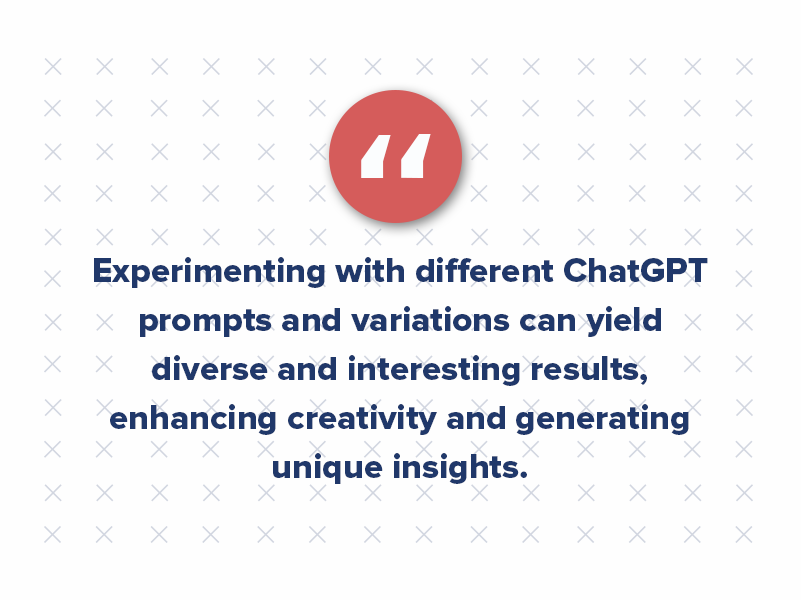
Experimenting with different prompts and variations can yield diverse and interesting results, enhancing creativity and generating unique insights. It’s important to refine prompts, iterate on them, and critically review the generated content to ensure it aligns with your objectives and requirements.
Making the most of this technology is all about what you put into it. The better the input (prompts), the better the output (content).
Here are 5 ChatGPT prompts you should try out this week:
- Website Copy: “Write me 5 new headline options for my website homepage that each focus on the different benefits of [company name] and [services]. Make the headlines punchy, engaging, and 8 words or less.”
- Email Marketing: “Write a personal follow-up email template for when a prospect visits our website at [website link] but never makes contact again. Include a relevant CTA to get them to book a [meeting/demo/tour/etc.].”
- Customer Support: “Write 3 follow-up responses for customers who leave bad reviews. Make each response different and focus on complaints about our [products/services], customer service, and [pain point], respectively.”
- Branding: “Write 2 options for a mission statement and 5 options for a company tagline that accurately reflects this company: [website link].”
- Content Generation: “Write a 1,000-word blog post about the benefits of using a [company name]. Focus the blog to highlight our [services] without sounding overly promotional. Include relevant keywords for SEO.”
Do I Still Need to Hire a Content Marketing Agency?
Hiring a content marketing agency remains essential. While open source AI is a powerful tool, a content marketing agency becomes an extension of your company, offering expertise, strategic thinking, and a deep understanding of your brand that open source AI cannot replicate (yet).
A content marketing agency collaborates with you to learn your multifamily brand inside-out, capturing its essence, voice, and values. They can personalize your content, crafting messaging that aligns precisely with your target audience’s needs and preferences.
Our team of experienced content writers utilizes the AI writing platform to effectively use our client’s monthly hours, utilizing AI-generated content as a starting point for us to refine, polish, and add a human touch.
This combination of AI and human collaboration allows us to generate content quicker and more efficiently, ensuring it meets the highest quality, accuracy, and engagement standards.
Plus, studies have shown that extensive editing is often required for AI-written content. A study by iPullRank and MarketMuse revealed that less than 2% of survey respondents (fellow marketers) leave the AI content as-is after it’s generated. 98% edit the content for grammar, subject matter expertise, accuracy, and bias.
So, while the platform offers tremendous value, partnering with a content marketing agency takes your brand’s content strategy to the next level, ensuring a personalized, effective, and impactful approach that resonates with your audience.
The AI Writing Tool That’s Changing the Marketing Game
Incorporating open source AI into your digital content marketing strategy can offer speed, efficiency, and fresh ideas to enhance your content creation process. It empowers marketers to quickly generate a high content volume, optimize for search engines, and engage their audience effectively.
However, while AI can produce blogs, emails, and even website content, it is not on par with humans in writing strong content. This is because AI cannot add the right context, elements of interest, or nuance to a story.
The takeaway? AI and intelligence tools are growing fast, but they have not overtaken humans’ abilities when it comes to certain tasks.
Want to see the effect the human touch can have on your content? Book a call with Criterion.B now. We’ll get started on your customized strategy and show you how to BEAT your competition with real-life, human-generated content personalized to your business and audience. We’re ready to chat and answer your questions about our content marketing service.

The Do’s and Don’ts of Social Media Interaction
Long gone are the days of stranger danger. Well, at least that’s true if you’re doing social media for multifamily. Nowadays, it is common — and almost expected — for an organization to interact with its customers, employees, and community online.
Multifamily professionals must engage and connect with their audience online to establish an authentic and interactive brand presence.

While social media for multifamily is an excellent tool for building your brand, it is essential to follow specific rules of interaction to ensure that your social media marketing efforts are practical.
Here are our top rules for marketing social media for apartments:
Rule #1: Use Humor Sparingly
Take a look at Whataburger’s Twitter account (@whataburger). You don’t have to be a writer for Saturday Night Live to run a strong Twitter account; sometimes, you must be a bit random. Whataburger focuses on how depressing life would be without it.
Regarding social media for apartments, showing a little personality and personalizing your property’s feed is essential. It allows you to be seen as more approachable and have more engagement with your residents, potential residents, and the community.
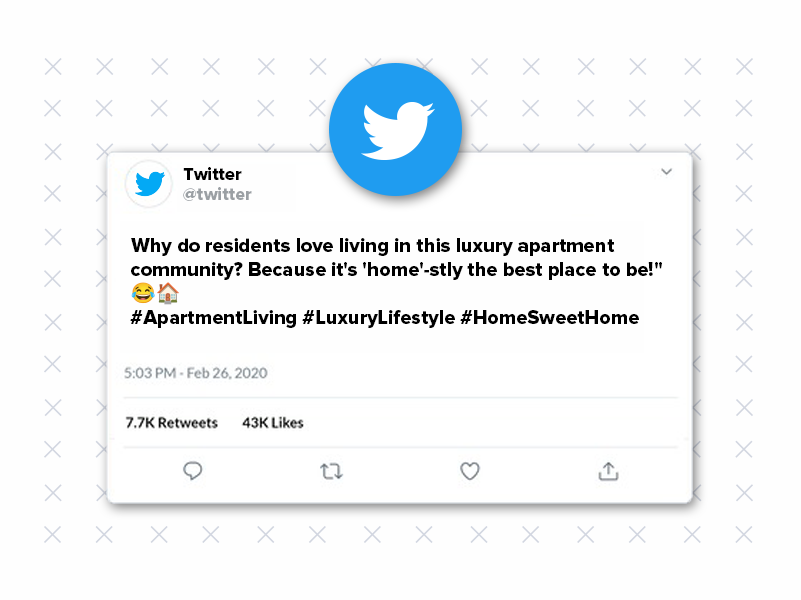
Humor can be an excellent tool for engaging your audience and creating a fun and friendly brand image. However, it is important to use humor sparingly and appropriately. Always consider your target audience and avoid offensive or insensitive content. Keep your humor light and relevant to your brand and community.
Rule #2: Don’t Be Afraid of Negativity
In the multifamily industry, negativity is plentiful online. Sometimes things don’t go as planned with your property, and you may receive a bad review online. Don’t worry. Instead, think about how you want to respond.
In almost every case, it’s the best strategy for companies to reply to these reviews and address the problem with a possible solution. What’s impressive about social media and the Internet in general is that you can talk one-on-one, so reach out to them. The reviewer’s negative experience may shed light on a more significant problem, which, once discovered, can be resolved so that higher-quality service can be experienced by all.
When potential residents surf the net for a place to live, they look at reviews. While bad reviews may affect their choices, properties engaging with reviews and offering solutions to the negativity will reassure them.
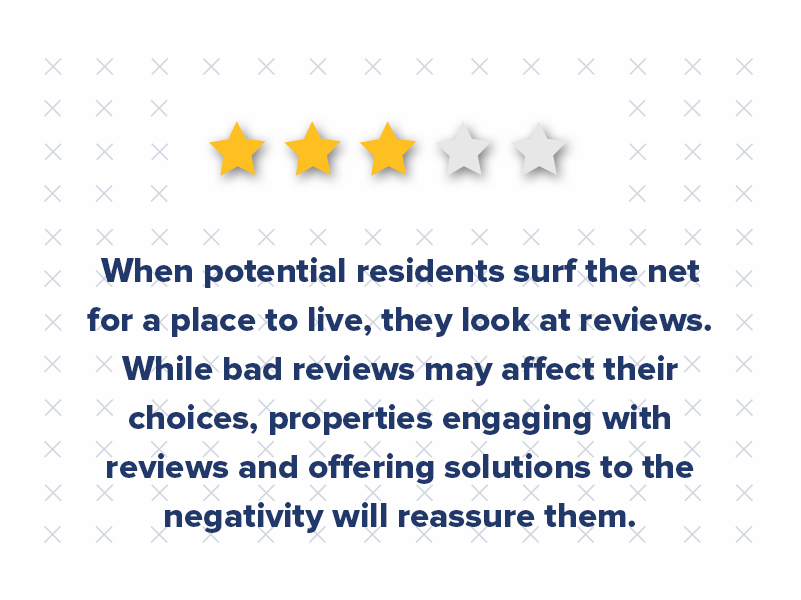
Rule #3: Use More Than One Brain
“Two brains are better than one” is not exclusively used for academic endeavors. One of our favorite social media accounts is Vogue’s Instagram account. They always have beautiful photos, and they’re not afraid to collaborate.
They’ve reposted photos and had budding artists take over their accounts, and they’ve done all this while sticking true to the core of their brand. For your multifamily marketing, you can collaborate with the community to showcase events, people, and issues that connect your property with your audience.
Collaboration is crucial when it comes to multifamily social media marketing. When creating content, property managers should work with the entire team to ensure that all aspects of the community are represented accurately. This may include input from the leasing agents, maintenance team, and residents.
Collaboration is also essential when managing social media accounts. Ensure you have a designated social media team responsible for managing and responding to social media inquiries and comments. Ensure that all team members are on the same page and understand the overall strategy for social media marketing.
Rule #4: Be Timely
Posting timely is a critical rule for social media marketing for multifamily apartments. Your content should be relevant and timely to your audience. For example, if there is an upcoming event in your community, post about it beforehand to encourage residents to attend. Also, consider current events and trending topics when creating content to stay relevant and connected with your audience.
Sometimes, we don’t do things on time. And that’s okay. However, with all social media, time is of the essence, so don’t be like that friend who tells you “Happy Birthday” a month late. If someone mentions you in a tweet, and you decide to favorite all mentions as a company, handle it immediately. More likely than not, it will make that person smile because getting some love from one of your favorite companies is always excellent.
Rule #5: Focus on Quality, Not Quantity
High-quality content is essential when it comes to social media for apartments. Your posts should be visually appealing, easy to read, and informative. Always use high-quality images and graphics to enhance your content. Ensure all posts are proofread and edited before posting to ensure the content is error-free and professional.
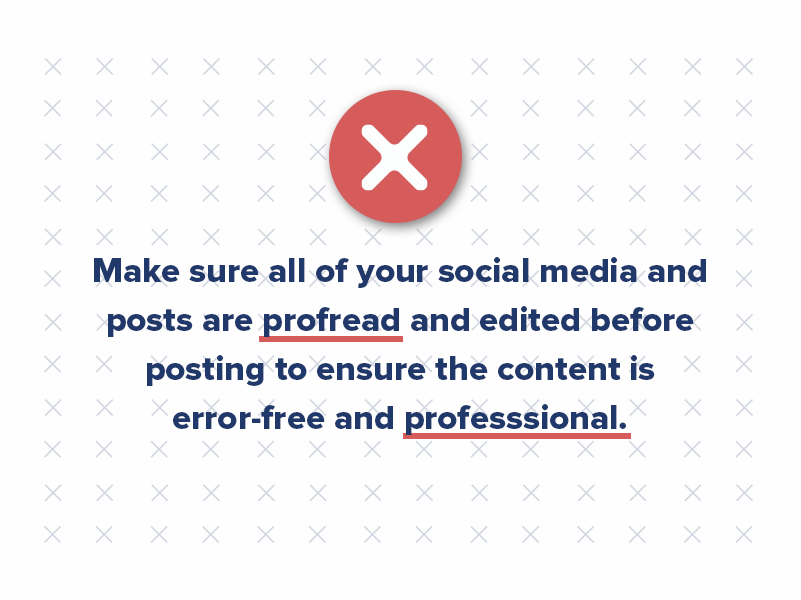
Rule #6: Respond to Residents
Social media for apartments is all about engagement, and it’s important to respond promptly to comments and messages. This helps build a positive relationship with your audience and demonstrates that you are attentive and responsive to their needs.
Remember to check your notifications (and message requests folder) regularly. Read, respond, and engage with your residents online daily. This shows them that you are not just a “posting machine” on social media but that you care about them.
Rule #7: Encourage User-Generated Content
Encouraging user-generated content is an excellent way to increase engagement on social media. Asking residents to share photos or stories about their experiences in your apartment community can create a sense of community and authenticity. Be sure to repost and share user-generated content to encourage further engagement.
Rule #8: Monitor Your Online Reputation
It’s essential to monitor your online reputation on social media. Be sure to respond to negative comments or reviews promptly and professionally, addressing any concerns or issues. This demonstrates that you take your residents’ feedback seriously and are committed to resolving any problems that may arise.
Rule #9: Be Consistent
Consistency is vital when it comes to your social media marketing. Be sure to post regularly and consistently to establish a routine and keep your audience engaged. Also, ensure that your multifamily brand messaging and visual style are consistent across all social media marketing platforms to create a cohesive apartment brand image.
By following these additional social media marketing interaction rules, property managers can create a strong and effective strategy that engages their audience and builds a positive multifamily brand image.

Is a Snapchat Marketing Strategy Right for Your Multifamily Property?
If you don’t use Snapchat, you’ve probably heard of it. It’s an app that allows you to share photos and videos with friends, but there’s a catch: within a few seconds of viewing the content, it disappears! Gone forever.
Seems a little silly, right? And yet, millions of people are using Snapchat.
In today’s digital age, social media has become an essential tool for businesses of all types, including multifamily properties. With many social media platforms available, choosing the right one can make all the difference in effectively marketing your multifamily property.
One platform that often gets overlooked is Snapchat. But is Snapchat still a relevant social media marketing tool for multifamily properties? And how can you effectively market your multifamily property on the right social media platforms?
Let’s dive in.
Is Snapchat Still Relevant for Multifamily Marketing?
When Snapchat first emerged, it was largely known as a platform for personal use, with its primary feature being ephemeral messaging. However, over the years, Snapchat has evolved into a powerful social media marketing tool, with features that allow businesses to connect effectively with their Snapchat target market.
As if you didn’t already know, Snapchat skews young. While Snapchat may not have the same user base as Instagram or TikTok, it still has an impressive number of users.
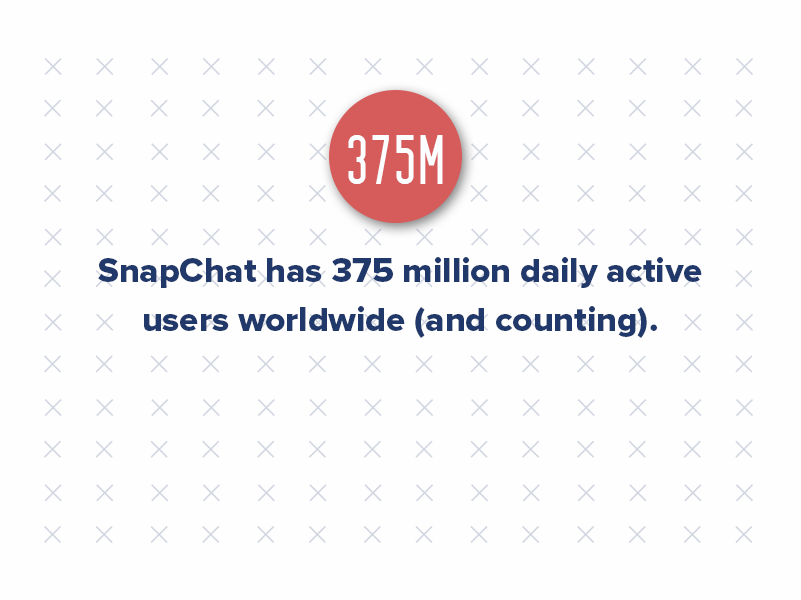
According to Demand Sage, Snapchat has 375 million daily active users worldwide as of March 2023. That is an 18.6% increase year over year. And the number of users is up from 265 million back in January 2021.
What’s more, Snapchat is particularly popular among younger demographics, with most users ages 18-24 using the platform.
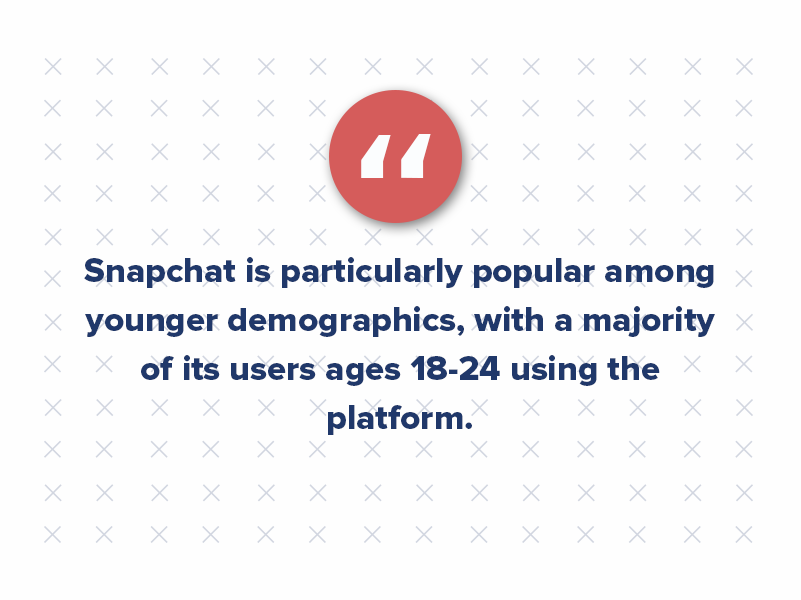
So, yes, this platform is still a relevant social media marketing tool for multifamily properties, especially if your Snapchat target market is a younger demographic.
(Pssst… If you are a student housing multifamily property, we highly recommend you jump on the Snapchat for marketing bandwagon!)
What’s the Value of Snapchat for Marketing Properties?
Although it seems counterintuitive, Snapchat content (photos and videos) is among the most engaging social media platforms. You probably wonder how disappearing content can be engaging, but that’s it! Viewing a “Snap” requires your undivided attention for a few seconds because if you don’t pay attention, you’ve missed the message (it’s gone).
Compare this to platforms like Facebook and Twitter, where we may passively “like” photos, doom-scroll our feed, or “save” articles with the best intentions of reading them later. But Snapchat is in the moment. It’s immediate, succinct, and convenient. And in return, Gen Z renters find it reasonable to invest a few precious seconds of their time.
It’s this disposability that makes Snapchat so unique. It’s the fleeting nature of Snapchat that drives such high user engagement.
Should You Hire a Snapchat Marketing Agency?
Do we recommend hiring a multifamily marketing agency for your Snapchat marketing strategy? Typically, we want to promote our multifamily marketing services, especially our work on social media for apartments. But we also pride ourselves in being transparent and good stewards of your marketing budget and time — so no, we recommend you keep your Snapchat marketing strategy in-house.
Why?
Snapchat is a highly personal platform. It’s not the platform where you share Stock images or promotional information about your property. This is the platform to offer behind-the-scenes content or promote things like resident events, local happenings, and funny anecdotes in your leasing office.
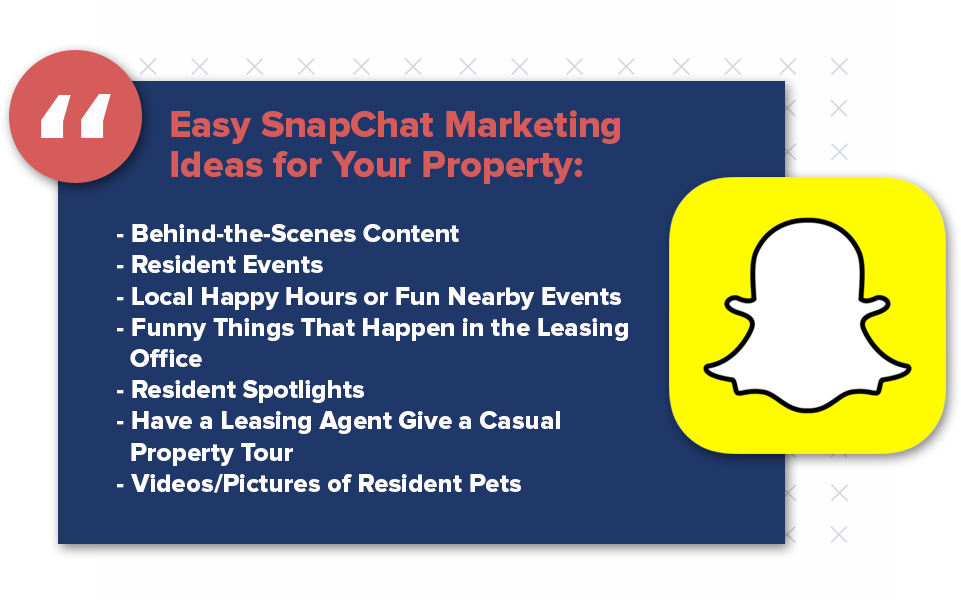
This is the type of platform you’ll want to hand over to your leasing agents and let them have some (professional and appropriate) fun with the platform! Let them use their creativity and share on Snapchat during downtime throughout the day. An agency will not be able to be at your property to share the type of personalized content your leasing agents will be able to. So leave platforms like Facebook, Instagram, and LinkedIn to your multifamily marketing agency and let your leasing team take the reigns on Snapchat!
How to Market on Snapchat (and Across Other Social Media Marketing Tools)
Now that we’ve established that Snapchat is still a relevant social media marketing tool for multifamily properties, here are some tips for marketing your property effectively on the right social media platforms.
1. Define Your Target Audience
Defining your target audience is essential before you start marketing your multifamily property on social media. Who are you trying to attract to your property? What are their interests, needs, and preferences? Once you clearly understand your target audience, you can choose the social media platforms that will be most effective in reaching them.
2. Choose the Right Social Media Marketing Tools
As mentioned earlier, numerous social media platforms are available, each with unique features and user base. Choosing the right social media platforms is essential to market your multifamily property effectively.
If your target audience is primarily younger demographics, then Snapchat, TikTok, Twitter, and Instagram may be the best platforms to focus on. On the other hand, if your target audience is more mature, platforms like Facebook and LinkedIn may be more effective.
>> Want some Instagram inspiration? Check out the Top Instagram Accounts for Multifamily!
3. Use High-Quality Visuals
Regardless of which social media platforms you choose, it is important to use high-quality visuals to showcase your property effectively. This includes professional photos and videos highlighting the property’s amenities, location, and overall vibe. On Snapchat, you can also use filters and lenses to create fun and engaging content that will appeal to your target audience. You can even create and sponsor your filter so nearby users can utilize it in their Snapchat photos.
4. Engage with Your Audience
Social media is all about engagement. To effectively market your multifamily property, it’s important to engage with your audience regularly. This includes responding to comments and messages, reposting user-generated content, and creating interactive content like polls and Q&A sessions.
With a unique platform like Snapchat, you will want to make sure you don’t have any missed Snapchat messages, photo tags, or mentions from your residents and prospects. Be sure to check your notifications and respond when applicable regularly.
5. Measure Your Success
Finally, it’s essential to measure the success of your social media marketing efforts regularly. This includes tracking engagement rates, follower growth, and website traffic. Regularly analyzing your social media metrics can refine your marketing strategy and optimize your efforts for maximum effectiveness.
Tap your Bitmoji/avatar in the top left-hand corner to find your Snapchat analytics data. This will take you to the home screen. Click the “Insights” tab to see your Snapchat analytics data.
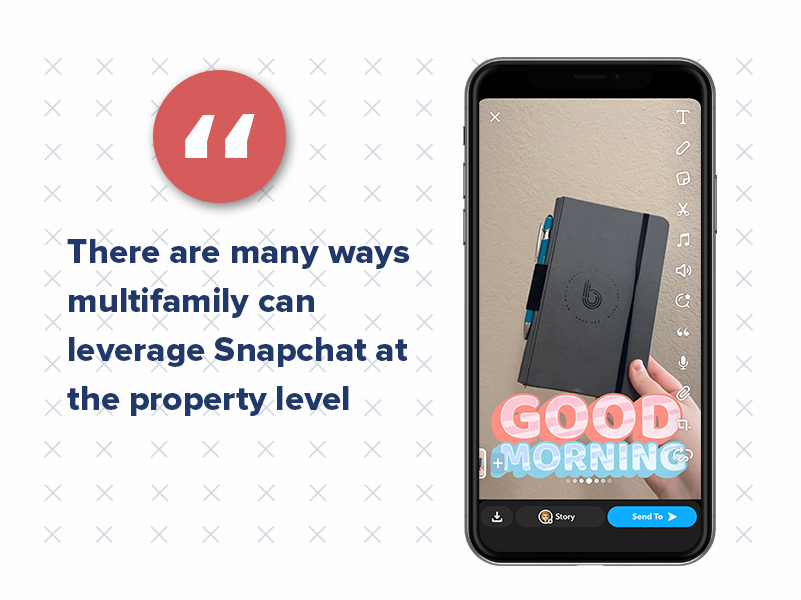
Opportunities for Multifamily Marketing on Snapchat
There are many ways multifamily can leverage Snapchat at the property level; let’s take a look:
- Direct snaps to and from residents: Once a property begins to connect with residents on Snapchat, they can send and receive ephemeral messages from one another. Likewise, sending quick and private messages to the management team can be a suitable medium. This feature is a fantastic way to empower your leasing office and the property staff to connect with residents. As the face of the property, these employees will be able to get to know residents uniquely.
- Geofilters: Geofilters allow users to create custom-branded artwork that will appear as an optional filter within the app in a specific geographic region. Users within that region can then add the geofilter to their messages and videos to friends. Aside from affordability, geofilters create an opportunity to reach and communicate with your residents within seconds. Properties should consider leveraging geofilters within their geographic area to take advantage of an event or holiday and target future residents.
- SnapStories: In addition to the traditional disappearing direct messages, Snapchat also includes a “story” feature that allows users to post public messages and videos that last for 24 hours. This allows property managers to create a story about their property and those living and working there. This can impact the way current and potential residents view your brand and, more importantly, how they view your property as a potential home.
Develop a Snapchat Marketing Strategy to Attract Residents
While Snapchat may not be as popular as Instagram or TikTok for marketing, it’s still a relevant social media marketing tool for multifamily properties, especially if your target audience is younger demographics.
The bottom line for apartment marketers: Snapchat is here. The multifamily industry has seen the rise and adoption of other burgeoning social media platforms, but why? because that’s where their renters are. That’s where their renters spend time, consume information, and interact. If you can’t speak Gen Z, it’s time to learn.
By defining your Snapchat target market, choosing the right platforms, using high-quality visuals, engaging with your audience, and measuring your success, you can effectively learn how to market on Snapchat to promote your multifamily property and attract new residents.
It’s Time to Take Digital Multifamily Marketing Seriously
Most digital marketers can probably relate to this social situation: Someone asks what you do for a living. After explaining that you work in multifamily digital marketing, the inquisitor follows up with some variation: “So, you play around on Facebook all day?”

Social media for multifamily vendors and developments, in particular, gets a bad reputation, with some business owners refusing even to acknowledge social platforms as legitimate marketing channels.
But if you think digital marketing is just fluff and noise, you are missing out on low-cost campaigns with great returns on investment that traditional marketing cannot compete with. Most businesses fail to realize that digital marketing offers more measurable value than traditional methods.
How a Company Generated $2M From One Blog
Over the years, blogging has transformed from a forum for teenagers into an affordable multifamily lead generation tool. To understand how this transformation occurred, let’s first examine how the internet has changed consumer behavior.
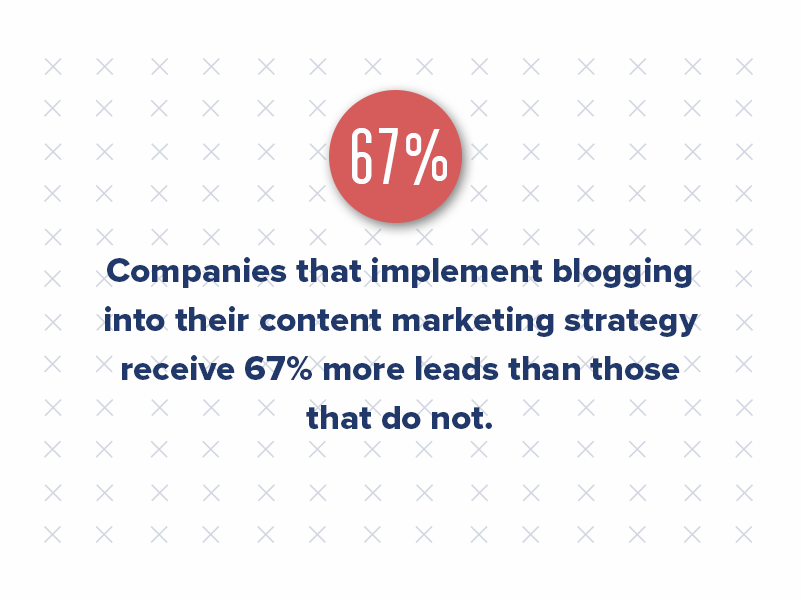
With a digital information repository at your fingertips, today’s consumers are more educated than ever. Gone are the days of visiting a store to speak to an expert or asking neighbors for referrals. Everything from pricing to reviews is found with a simple search.
No matter what industry or consumers you serve, customers have questions, and you can guess where they go for their answers — Google. So, how can you take advantage of this? By answering those questions on your company’s blog or FAQ page.
Marcus Sheridan, one of the earliest content marketing proponents, generated $2 million for River Pool & Spas when he published a blog post on the company’s website answering a simple question: “How much does a fiberglass pool cost?”
What did the blog post cost him? A half-hour of his time and maybe some web analytics tools? We’ll take that ROI.
According to Tech Client, businesses have a 434% higher chance of a high ranking on search engines if they feature blogs as part of their website. Additionally, HubSpot found that companies that implement blogging into their content marketing strategy receive 67% more leads than those that do not.
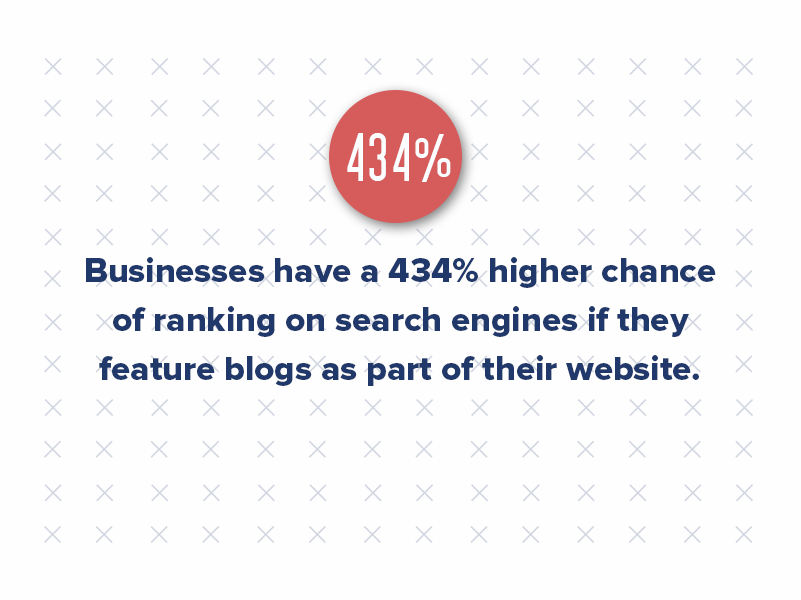
Content marketing might seem pretty straightforward, but like any marketing campaign, it is important to have a strategy. For most businesses, you are not blogging just to blog; you create content to drive your marketing funnel.
Social Media’s Biggest Value-Add for Business
Multifamily owners often ask, “Is social media a legitimate way to generate multifamily leads?” But those owners might be asking the wrong question.
The value of social media is not measured in leads, but rather, it is measured through customer experience. According to Forrester data, a relationship exists between customer experience and stock price. People are willing to pay a premium cost for the experience with a brand.
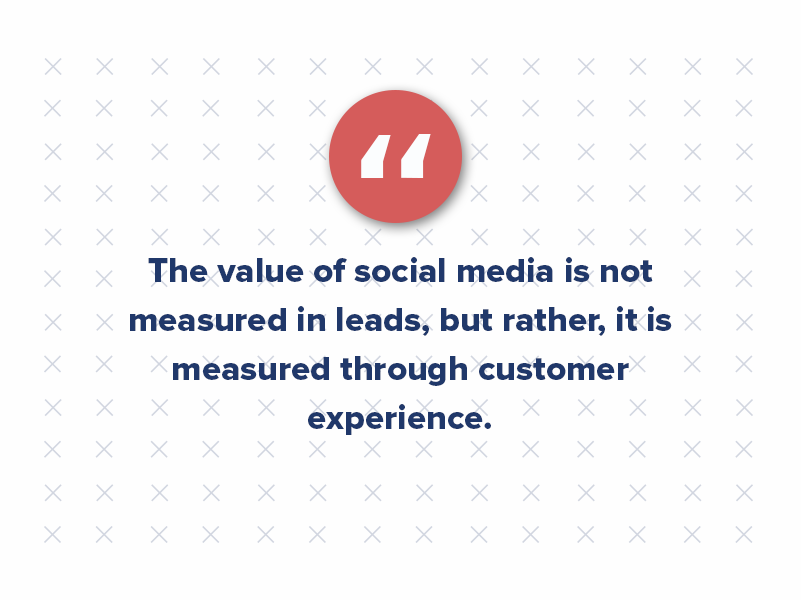
Additionally, improving customer experience can save your company big bucks. In fact, Sprint saves $1.7 billion each year by determining and mitigating the root cause of customer dissatisfaction from calls made to its contact center.
And as it turns out, social media is crucial to improving customer experience. The internet allows word-of-mouth communication to spread easier than ever, both positive and negative.
In the multifamily industry, for example, negative commentary from residents is commonly found across social media and online review sites such as Yelp, Twitter, and Google business pages. Residents who are frustrated with a property’s maintenance issues or poor customer service often express those feelings publicly online. How a multifamily property responds will determine how a negative comment affects your business.
However, each part of your marketing strategy should fit into one cohesive piece. Your website, social media presence, user experience, customer experience, etc., should work harmoniously to establish a successful inbound marketing plan.
You Must Talk Marketing ROI (4 Key Takeaways)
As marketers, we are constantly faced with the battle of justifying ourselves and our multifamily marketing agency’s role in a company’s ROI. We must always find ways to prove to CEOs that marketing contributes to the bottom line.
But how?
Here are 4 ways to convince multifamily owners and CEOS that marketing ROI matters.
1. Be relevant — set SMART goals.
Do you find yourself constantly sharing statistics that discuss retweets, follows, visits to the website, etc.?
These stats are important, but if you have not established true goals and understand how and if your work is contributing to the bottom line, STOP IT! It’s time to set up your SMART goals, communicate with your sales team, and start being relevant to what is most important to the CEO and company: ROI.
2. Play offense, not defense.
Believe it or not, about 69% of CEOs believe that marketing is a waste of time, money, and resources. To stay on the offense, you must clearly define your goals, ensure that sales and marketing are happy, and discuss the purpose behind your goals.
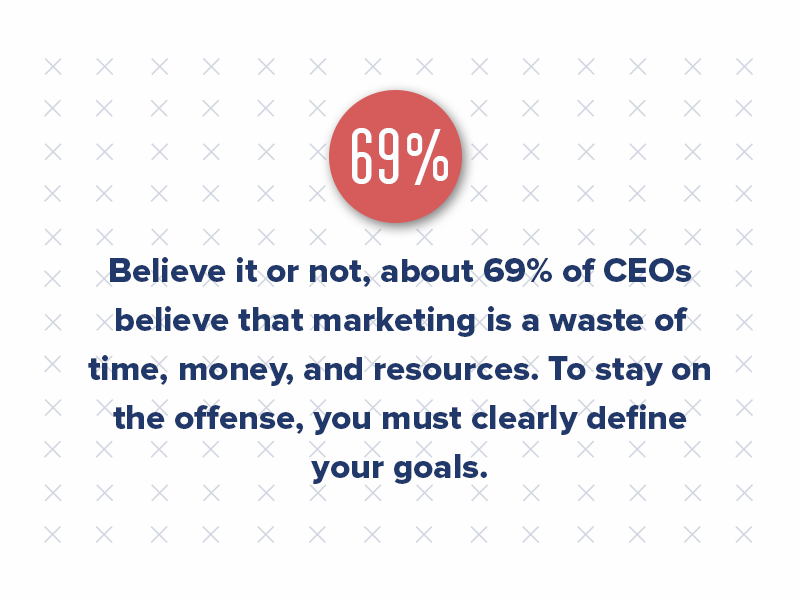
3. Always go after the 3 Hs.
- Head – Explain your plan of action. Defend your strategies with case studies, numbers, etc. Win over your team with proof!
- Heart – If people aren’t truly vested in your idea with their heart, you will lose them. Find out what’s important to them and how to tie your new goals to theirs.
- Hands – Now that you’ve won over your team, you’ve got to get them to get back to (or start) work! Play out those call-to-actions.
4. Prepare to show your medal.
In business, you will fight many battles. You will be criticized and put through the wringer. But, at the end, these obstacles will refine your character — just like a medal has to go through fire to be reshaped and altered.
Take risks and be the change that will keep your organization moving forward.

Generative AI vs. Human Writers: Why You Need BOTH in Your Strategy
By now, you’ve likely heard about OpenAI’s ChatGPT and other chatbot artificial intelligence tools.
And if you haven’t heard of these AI writing tools yet, settle in and don’t skim over the good parts of this blog because this one is important.
Generative AI has taken the marketing world by storm. With advancements in natural language processing (NLP) and machine learning, AI copywriting has become an increasingly popular tool for any business to interact with its customers — and the multifamily market is no exception to this growing trend.
AI-powered writing tools, in particular, are a leading example of how generative AI is changing the marketing world. But while these tools can automate some multifamily marketing processes, human writers and editors are still essential.
Why? ChatGPT might be revolutionizing how you handle content marketing, but did you know it isn’t always factual? Did you know some generative AI content is considered plagiarism?
We ALL have our limits, and that includes AI writing tools. We found those limits and think sharing them is important so you can utilize ChatGPT (and similar tools) to support your apartment marketing efforts the RIGHT way.

What is ChatGPT?
ChatGPT stands for “Chat Generated Pre-Trained Transformer” and is an AI-powered chatbot that utilizes an NLP model developed by OpenAI. It uses machine learning algorithms to analyze vast amounts of data to generate content that reads as if a human wrote it.
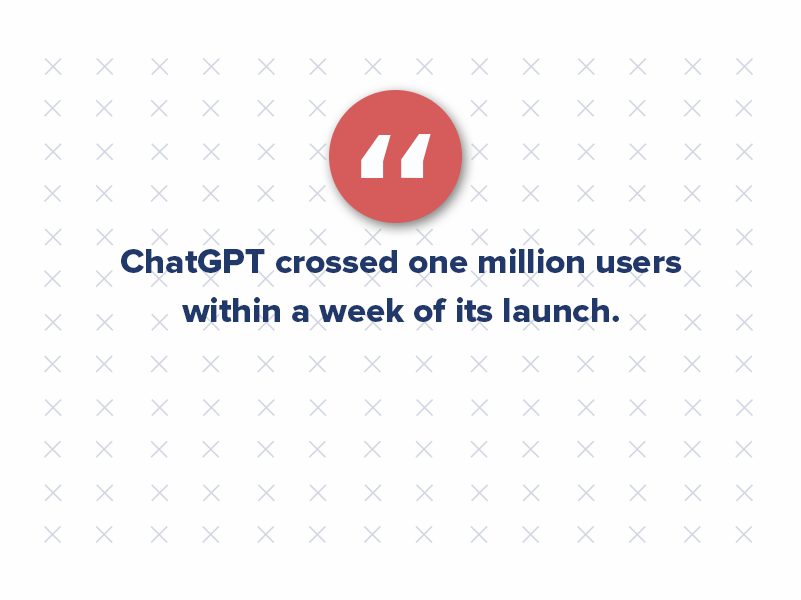
Since ChatGPT launched in November 2022, the world hasn’t stopped talking about it. There are many use cases and ideas, but we haven’t seen enough comprehensive use cases to leverage it in multifamily marketing.
Generative AI Tools and Industry Growth
The generative AI market is booming, with over 2,000 tools now available to help businesses create content, streamline workflows, and innovate across industries. The rapid expansion of this market is fueled by growing interest in AI-driven solutions and substantial investment. In fact, between 2022 and 2023, total investment in generative AI skyrocketed by an astounding 407%. Let’s explore some of the leading tools driving this transformation:
- ChatGPT (OpenAI): A widely used conversational AI tool capable of generating text, answering queries, and assisting with creative projects.
- Google Bard: An advanced conversational AI by Google that excels in generating detailed responses and explanations.
- Gemini (Google DeepMind): Combines generative AI capabilities with Google’s vast knowledge graph for nuanced and reliable responses.
- AlphaCode (DeepMind): A coding-specific AI designed to assist developers in writing and debugging software.
- GitHub Copilot: Powered by OpenAI, this tool enhances coding efficiency by providing contextual suggestions and code snippets.
- Peppertype: Offers content templates for writing articles, meta descriptions, and marketing emails.
- Rytr: Creates SEO-optimized titles, blog posts, emails, and advertisements with a focus on ease of use.
- Jasper: A content generator tailored for marketing teams, featuring multi-language support, collaboration tools, and content templates.
- Copy.ai: Focused on content marketing, this tool generates blog posts, social media updates, and email campaigns.
- MidJourney: A leading AI tool for generating stunning visual designs and artwork.
- Stability AI: Known for developing tools like Stable Diffusion, specializing in high-quality image generation.
A Market on the Rise
The generative AI industry is experiencing unprecedented growth, attracting interest from businesses across sectors. From crafting marketing content to automating repetitive tasks, these tools offer transformative potential. With investment levels surging and innovation accelerating, generative AI is poised to reshape how we approach creativity, productivity, and problem-solving.
Whether you’re a marketer, developer, or business leader, understanding and leveraging generative AI tools can provide a significant edge in today’s competitive landscape. As the market evolves, staying informed and experimenting with these technologies will be key to unlocking their full potential.
ChatGPT by the numbers
- On March 14, 2023, OpenAI launched GPT-4 technology in the ChatGPT Plus Plan, which allows it to generate 25,000+ words in output. As well the model understands 26 languages.
- ChatGPT reached one million users within a week of its launch and 57 million monthly users in the first month.
- ChatGPT crossed the 100 million users milestone in January 2023.
- 13 million individual active users visited ChatGPT per day as of January 2023.
- Microsoft invested $10 billion in OpenAI, gaining 46% of the company’s stake. OpenAI received $ 1 billion from Microsoft in the initial stages of development.
- ChatGPT owner OpenAI predicts that by the end of 2024, they will generate revenue of $1 billion. $200 million in revenue is expected by the end of 2023.
The benefits of AI-powered writing tools
The primary advantage of ChatGPT is its ability to produce large volumes of content quickly and efficiently. This makes it an ideal tool for marketers and content creators who must quickly produce a high content volume. Additionally, ChatGPT can provide marketers with fresh ideas and perspectives on a given topic, helping them to create more engaging and compelling content.
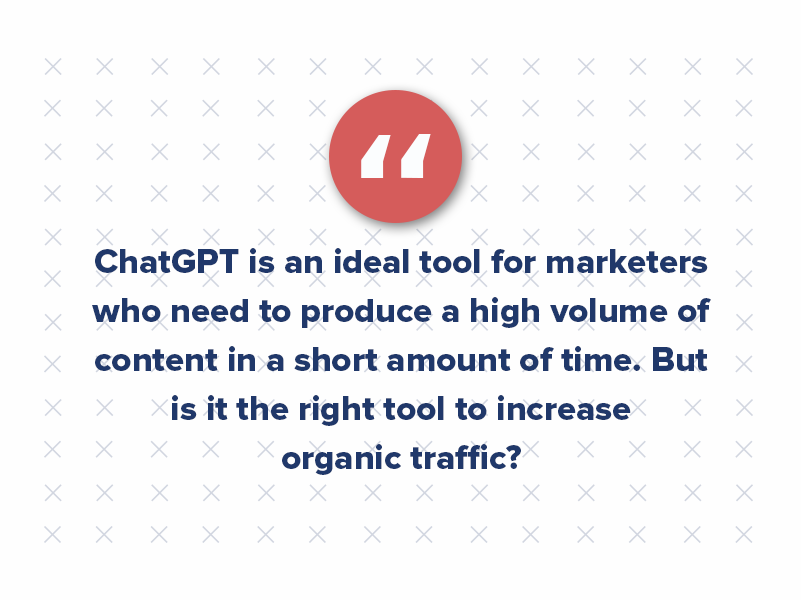
Regarding blog writing and marketing, generative AI is an excellent tool for generating ideas and starting the writing process. By providing a prompt, such as a topic or a keyword, ChatGPT can quickly generate several paragraphs of text that can serve as a jumping-off point for further refinement by a human writer or editor.
Moreover, ChatGPT can help marketers create optimized content for search engines, which is essential for driving website traffic. ChatGPT can suggest keywords and phrases that can improve a blog’s search engine ranking by analyzing search queries and content related to a given topic.
7 limitations of AI in digital multifamily marketing
While generative AI offers several benefits, it is important to understand its limitations. ChatGPT’s writing is generated based on algorithms and statistical patterns, so it may not always capture the nuance or tone that a human writer could convey. ChatGPT also has limited knowledge of cultural and contextual factors that may impact how a specific audience receives content.
Additionally, ChatGPT may struggle to generate content for complex or technical topics requiring high expertise. In these cases, relying on a human writer or editor with the necessary knowledge and experience to create high-quality content may be more effective.

1. AI lacks creativity and personalization.
Despite the many advantages of ChatGPT, human writers and editors are still necessary in today’s marketing world. Human writers bring a level of creativity and personalization to their writing that AI-powered tools cannot match. They can inject personality and voice into their writing that resonates with their audience and helps to build a connection with them.
Furthermore, human writers and editors can provide a level of quality control that AI-powered tools cannot match. They can review content generated by ChatGPT to ensure that it is accurate, engaging, and error-free. They can also ensure that the tone and style of the writing are consistent with the brand’s voice and values.
When you compare content written by AI vs. a human, AI doesn’t have a lot of creativity or personality. Take the following paragraphs as an example. One was generated by AI, and the other by me (the Manager of Content at Criterion.B). I wrote a few paragraphs about web design — specifically, the No. 1 mistake marketers make when building or redesigning their websites.
After writing my version of the topic, I asked ChatGPT to “Write a couple of paragraphs about the No. 1 mistake marketers make when building or redesigning a website.”
Here is my take on the results:
I ran both pieces of content through a plagiarism checker. My content had 0% duplicate content. Meanwhile, 5% of the AI-generated content was considered plagiarism.
Additionally, as you can see, my content was much more informal, specific, and personalized. The AI-generated content (while it is good content) is much more formal, structured, and even a little bit stale in comparison.
While it’s not a bad paragraph and could be used in a blog somewhere, imagine an entire blog written using ChatGPT and how it would sound. The AI-generated content is a bit heavier to read, which could lead to a higher bounce rate over time if all your content is AI-generated.
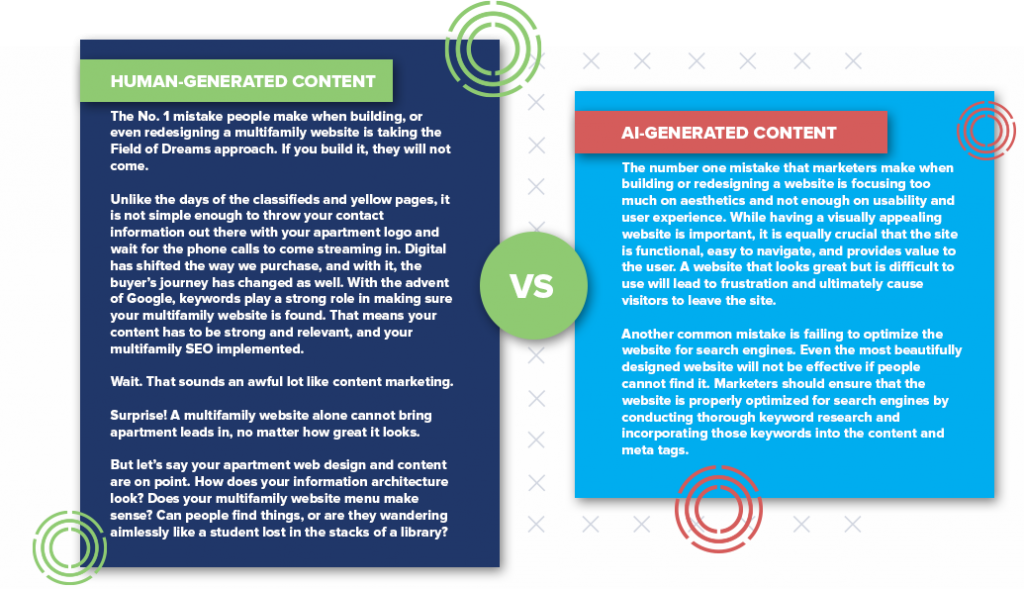
2. AI lacks originality (possible plagiarism alert!)
ChatGPT is not your content creation savior. Sure, it’s powerful and helpful, and maybe the tool will improve significantly in the months and years to come. But for now: relying on ChatGPT for ALL of your content is a disaster waiting to happen.
AI learns from existing content on the web, so it replicates what is already out there. This means it could be a literal copy of something else online. (See the above example where the AI-generated content had 5% plagiarized content.)
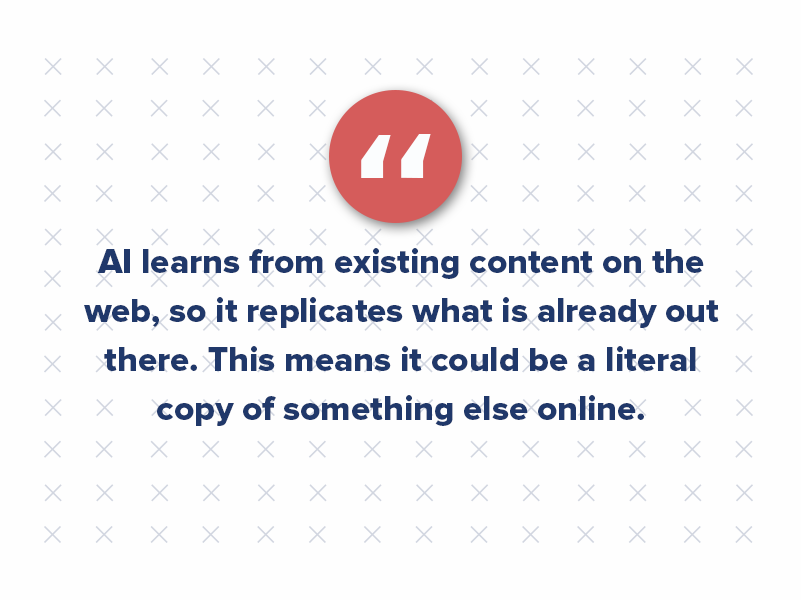
3. AI utilizes an outdated learning model.
Generative AI cannot always provide the correct answers. Did you know that some content from ChatGPT and other writing tools is inaccurate information? This is because AI pulls data from top ranking articles or from what it can find online, so the stats you might see in your content might be inaccurate, outdated, and likely inaccurate. Think about the disclaimer provided in all generative AI results about how it’s “experimental” and users should always fact-check the results.
4. AI lacks emotional intelligence.
AI may be able to simulate human writing, but it lacks emotional intelligence. Human writers and editors can use their emotional intelligence to understand customer needs and write specific content centered around those needs. Emotional intelligence is crucial to successful multifamily marketing, as customers are more likely to engage with a business that understands their needs and values.
5. AI does not know your brand voice.
Every business has a unique brand voice and tone representing its personality and values. Human writers and editors are essential for maintaining and developing a consistent brand voice across all apartment marketing channels. Artificial intelligence tools may be able to write blogs, emails, and website content, but they cannot understand your authentic brand voice. ChatGPT has a lack of context, so AI is not recommended to be used by businesses. The bottom line: Generative AI does not know your business like you do.
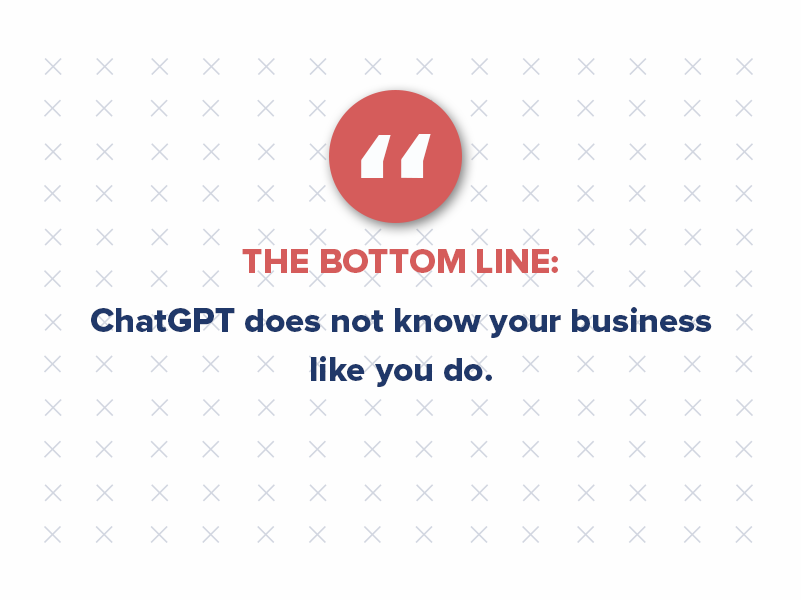
6. AI content has errors.
We are all human (except AI, ha!) and make mistakes. But when you rely on an AI writing tool to generate content for you, you expect it to be nearly flawless. Or, at the very least, free from major errors.
I’ve been testing ChatGPT and other writing tools like Jasper.ai for several months and discovered the content is riddled with errors. Everything from run-on sentences and passive writing to missing punctuation and duplicate content.
Consider the below example. Jasper.ai generated the first paragraph and includes a variety of grammatical errors. While these errors are insignificant, they are still errors that would not be there had human-generated content. Then, compare the “After” paragraph, which is the same AI-generated content that was then edited by me (an actual human editor). Notice the difference in the paragraph’s flow, clarity, and readability.
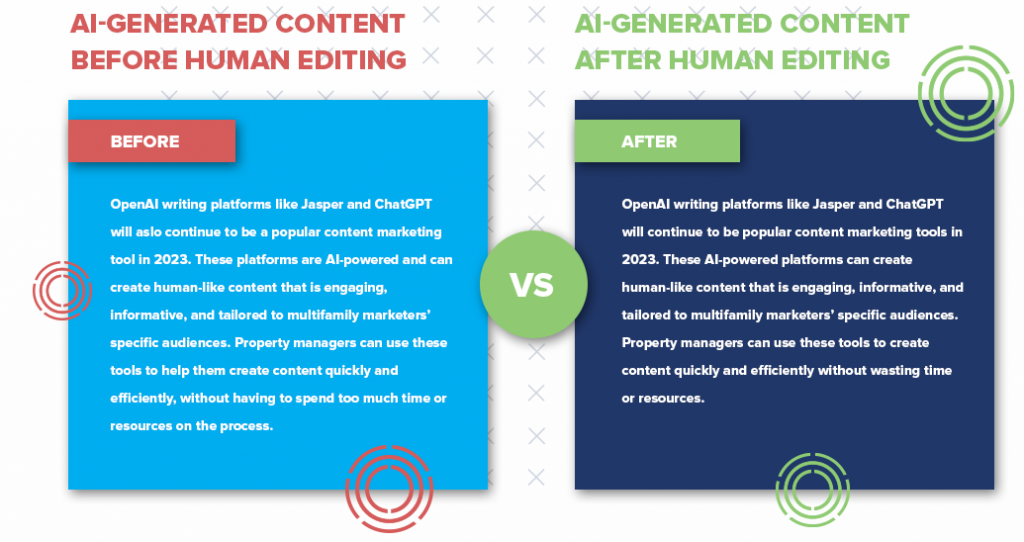
Although Google doesn’t penalize grammar and spelling outright, the bots that scan your content may find it harder to understand what the page or article is about, which could result in lower page rankings and perceived credibility.
7. AI content is not guaranteed to rank well.
Fun fact: Google doesn’t love AI-generated content. Google did release its own AI writing tool, Bard, so the space may change in the coming months and years, but for now, Google can sniff out AI content a mile away.
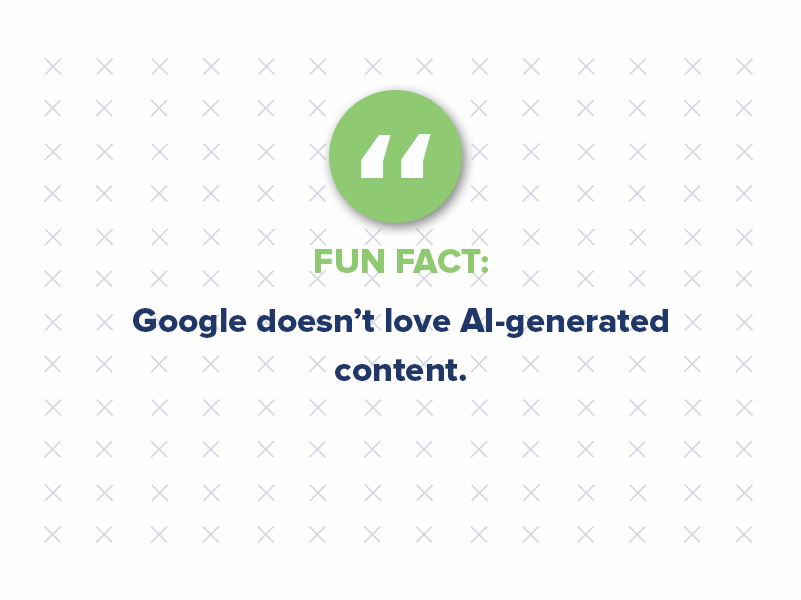
And did you know that Google punishes AI-generated content? That means anything a chatbot spits out will NOT boost your apartment SEO ranking. In fact, it’ll actually hurt it.
How will AI affect search?
Quality still matters over quantity. Just because ChatGPT can help you crank out more content does not mean you will rank well for those pieces. You need an SEO expert to help you rank and strategize effectively.
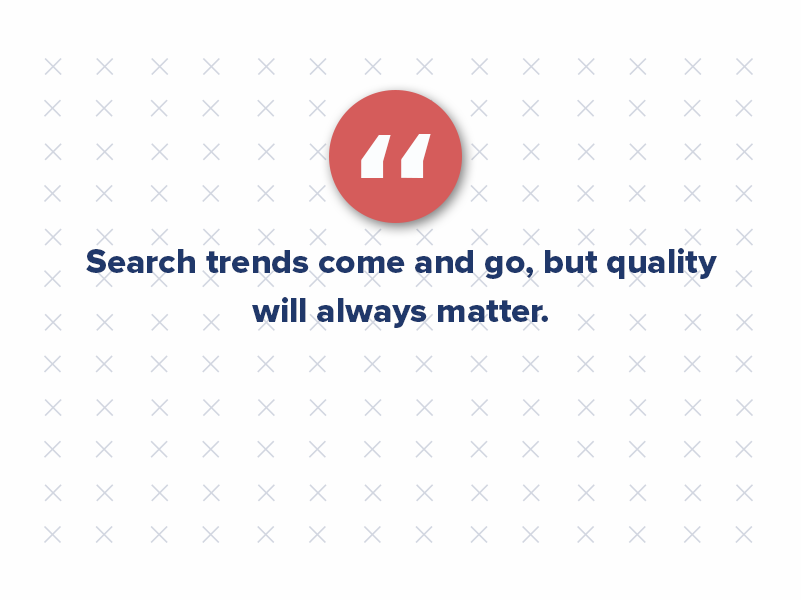
ChatGPT content lacks EEAT (expertise, experience, authoritativeness, and trust). You need this in your content to do well in Google search engine result pages (SERP).
Google provides users with TONS of answers to their queries based on SEO strategies, keywords, backlinks, etc.
A chatbot provides one singular answer. Just one answer. How does the chatbot know the ONE answer to that query? Is bias involved? What if they pulled inaccurate information for the answer? Consider these questions when using ChatGPT, Jasper.ai, Bard, and other tools to help generate answers to your queries and content for your blog.
Will AI replace humans?
No! Remember, ChatGPT requires human editing. Effective apartment marketing requires tapping into the human element, which is something AI can’t do (yet). Natural language processing could change this in the years to come, but for now, ChatGPT is more of a stepping-off point for your content.
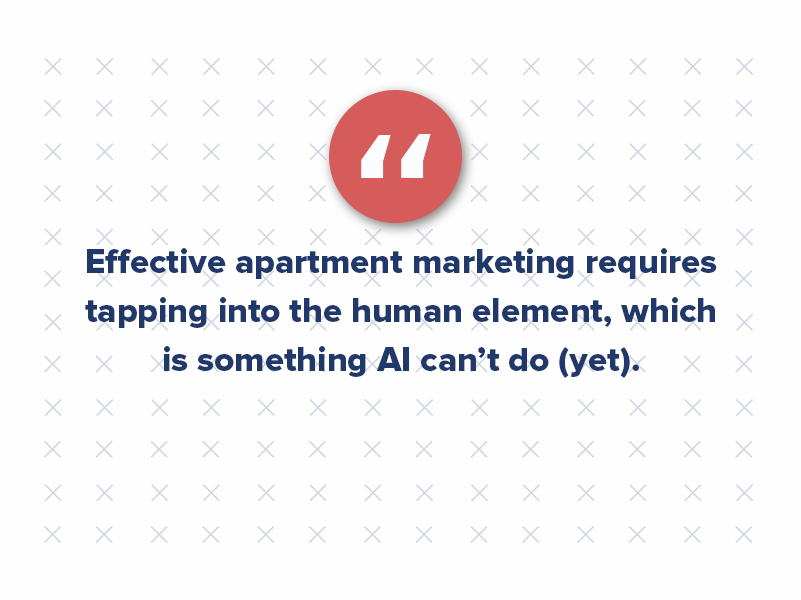
Marketers should harness AI to help batch-create content and save time, then use human editing to refine, hone, and detail the pieces. That’s how you create quality content that resonates. The key is to use AI for what it does best and supplement it with strategic human input.
How to beat your competition at the content marketing game.
So … outdated content, factual errors, plagiarism, and no guarantee of good SEO? That’s not a great recipe for your digital marketing strategy if you ask me.
ChatGPT is an excellent tool to start the writing process, but it should be viewed as a jumping-off point rather than a complete replacement for human writers.

There’s no replacement for human ingenuity. Over the next year or so, AI-generated content will explode. ChatGPT has changed everything, and it’s made everyone (including your competition) think they can pump out a bunch of content without their audience noticing.
But what happens when Google evaluates that content? It will notice the lack of originality. It will read like a robot wrote it — because a robot did! That’s what your competition is going to do. And what’s the best way to compete with your competition? Beat them at the content marketing game!
Want to see the effect the human touch can have on your content? Book a call with Criterion.B now. We’ll get started on your customized strategy and show you how to BEAT your competition with real-life, human-generated content personalized to your business and audience. We’re ready to chat and answer your questions!

Exploring the Benefits and Drawbacks of Hiring an Inbound Multifamily Marketing
Should I hire an inbound marketing agency? This is a question that comes up naturally as businesses discover the inbound process.
Inbound marketing is a complex and intensive marketing methodology that offers a strong ROI when implemented but can be difficult to navigate. While several businesses opt to utilize the inbound methodology in-house, many others prefer to employ an inbound marketing agency.
As an inbound marketing agency, we admit to being biased in this area. However, the points can be viewed objectively despite this.

The Complexity of Multifamily Inbound Marketing
To take on a multifamily inbound marketing approach, you must first understand what it takes to run a successful campaign. A campaign is comprised of multiple bits and pieces working together to accomplish a specific goal. That goal may vary but should still utilize the same fundamental resources and tools.
Being fundamentally content-focused, people need clarification on multifamily inbound marketing with content marketing. In reality, inbound is much more complex. This methodology utilizes content but relies on a strategy to target that content and use tools like forms, landing pages, and offers to gather pertinent information from prospects to convert them.
The success of inbound content, however, is dependent on other aspects. For example, comprehensive knowledge of your buyer persona’s journey and lead qualification for your business is important. Without these factors, your content could fail to attract the desired audience. Or, you may be able to attract the audience but fail to convert and qualify them properly due to asking the wrong questions.
Items like content creation are also heavily dependent on the processes you have in place. Without methods and consistency, you could fail to build a strong foundation. This, in turn, could impact the success of any ongoing campaigns you choose to operate.
What does this mean for your multifamily inbound marketing endeavors? Potentially nothing. Or potentially everything. Several businesses can adopt and enact inbound with great success. Others try and end up using an inbound marketing agency or abandoning this process altogether. The most important factor in your outcome is the level to which you understand the complexities of this strategy.
Taking the Inbound Marketing Agency Approach
If you choose to take the inbound marketing agency route, there are many things to consider:
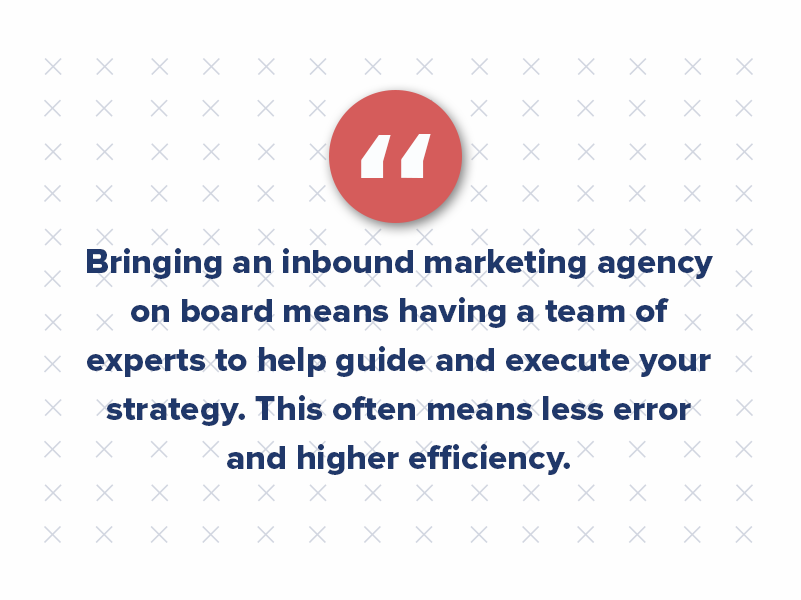
Pros
- Bringing an inbound marketing agency on board means having a team of experts to help guide and execute your strategy. This often means less error and higher efficiency.
- Hiring a team rather than an individual means having the best of the best to generate your content, including designers, writers, and strategists.
- Utilizing a multifamily marketing agency allows you to focus on other business factors.
- Using a team of experts ensures that all knowledge in the field is current and up to date.
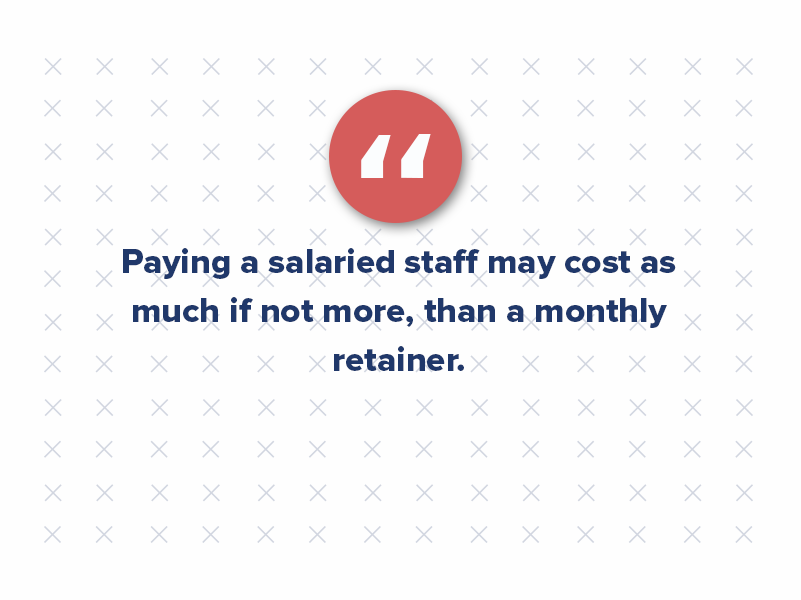
Cons
- An inbound marketing agency has the perception of being more expensive than in-house marketers. In reality, if you require hiring a team to implement your strategy, it might be comparable in cost. However, agency retainers tend to cause sticker shock.
- When working with an inbound marketing agency, communication gaps may exist. An agency will need time to develop knowledge in your field and to execute your needs, as they are away from the office with you.
- Negotiating project scope can be challenging, as agencies must balance their work with other clients. This means that issues may arise when a project is underestimated in hours. This could impact the project and/or your costs.
- Agencies require kick-off time to educate themselves on your industry. They must learn about your company to ensure your marketing system is in place.
Taking Inbound In-House
Taking multifamily inbound marketing in-house can be tempting, but this approach has several positive and negative factors.
Pros
- In-house marketing communication is much simpler and quicker. You will not have to onboard an agency or worry about passing along the correct information. Instead, the team working on the marketing is local and aware.
- Using a marketing manager or a small in-house team means more easily aligning your strategy with other business efforts.
- An in-house team may be able to implement strategy more quickly because there’s no learning curve.
- Your team controls the related decisions, successes, or failures.
Cons
- This type of marketing takes time to learn and even more time to perfect. This can be difficult for a team to start.
- Paying a salaried staff may cost as much if not more, than a monthly retainer.
- If key staff members leave, much training is lost, and replacements may have a different knowledge base.
- Your staff will have a different skill depth than professionals to produce top content and design.
- An in-house team may also be spread too thin, especially starting. Without a full team, your in-house department will likely wear multiple hats.
The Deciding Factor
If things look pretty even to you now, they are. Choosing an in-house team vs. an inbound marketing agency is simple enough for some companies based on their needs. For others, it’s too early to determine which will work best for their company. What is the best thing to do when choosing? Remember your goals, timeline, budget, and plans for scalability to determine which options will meet and support your business.
The True Cost of Doing Inbound In-House
Many businesses need help with the choice of choosing an agency vs. doing the inbound marketing in-house. Some factors impact the success of each option. However, what most businesses need to take into account is cost.
When we discuss cost, we don’t necessarily mean the monetary costs of running a campaign (though that certainly is a component). Instead, we mean non-monetary costs like time, resources, staff training, etc. Knowing the significance of these costs on an organization is challenging when deciding which option is best for you.
To understand this, you must first know what your costs are or will be.
Hiring and Training an Apartment Marketing Team
The highest cost to companies looking to do inbound marketing in-house is staffing. This impacts teams without a marketing department and those with an established one. Businesses’ most significant concern is bringing a team to use a new strategy like inbound or finding the talent to implement it.
If you already have a team, it means spending money on training. And the training and transition of your team to inbound methods can easily take months. It means hiring and onboarding new staff to implement your plan if you still need a team.
Additionally, adding staff salaries is pricey. The national average wage for a marketing manager is $74,532, per Glassdoor. If you hire a director, that salary can cost you $169,058. Then you must account for the rest of the team — designers, copywriters, strategists, and developers.
Factor in the two to three months it will take for onboarding and add that to those costs. Then consider turnover, additional hiring as needed, and additional training.
Quality and Quantity of In-House Marketing
Another factor to consider is understanding the costs related to workflow variance. There are busy times and lulls, which will impact your team’s efficiency and productivity. This can affect the overall return on your apartment marketing investment.
Quality is trickier to quantify or put a number value to directly. However, it is an equally important cost. The quality of your efforts impacts the effectiveness of your strategy. With a newer team, a dip in quality will recover over time but may cost you apartment leads or require additional efforts to meet goals. Ultimately, this means more time spent on the campaign than originally budgeted.

Managing Resources
An inbound marketing agency will have several proven resources, services, and software that are efficient in its processes. Usually, the agency covers these costs and will split and pass the cost amongst each client. However, when doing your marketing in-house, you will be forced to learn which resources work for you and cover the entire cost yourself. This will likely be more than what the agency charges you for its resources.
The reasons for this are widespread. First, you’ll likely have more trial and error associated with these resources as you learn the effectiveness of different tools over time. In addition, while an agency will pay a high cost for a high-level tool, that cost spread among many clients will mean a small cost to you. There’s also the cost of learning and developing processes for a tool. Finally, the time that goes into finding and researching a tool, learning that tool, and training staff is a cost to you.
Know Your Capabilities
While all these costs aren’t necessarily deterrents from bringing multifamily inbound marketing in-house, they are often overlooked. Therefore, when calculating the value of an inbound marketing agency vs. taking it in-house, it’s important to analyze the cost and time factors to determine the true impact on your company. You will only truly capture the differential and determine the most effective method.

Why Video Is Important for Your Apartment SEO
As technology continues to improve and become more ingrained into our daily lives, video has taken the main stage. Platforms like TikTok have made binging short, quick videos easy for anyone with a smartphone. YouTube countered this with its feature called “YouTube Shorts.”

However, video isn’t just for show. There are fundamental benefits that videos add to your apartment SEO efforts. Not everyone is energized by recording videos of themselves for their properties. However, these may inspire you to reconsider an SEO video marketing strategy.
Local Geodata of Videos
Similar to photos you take from your smartphone, videos capture embedded and local geodata within the files. For example, Brotherly Love Real Estate, a homebuyer starting in Philadelphia, PA, expanded to the west coast. They began their SEO video marketing efforts in Southern California, utilizing videos to help increase their rankings.
Brotherly Love Real Estate went to each city they wanted to rank in, recorded a video, posted it directly to YouTube, and placed it on their respective website pages. This website shows how they now buy and sell houses in San Diego from the success of their videos.
The geodata gets stored in the video file through location-identifying features from the smartphone. Google recognizes that, allowing it to carry weight when considering which multifamily website to rank for certain local search terms. It can feel tedious at times to record videos and then upload them. However, the results can be worth pursuing.
Increases Time on Page Through SEO Blog Writing
Another ranking factor that Google considers when determining which websites to show for a certain query is time on page. The more real, local users spend on your multifamily website, the more authoritative Google will consider you. They assume that if people spend tons of time reading through multiple pages or posts on your site, you must know what you’re talking about. Your content is viewed as credible, trusted, and rank-worthy.
Adding a video to your pages and posts is a great SEO video marketing strategy to encourage users to linger on your pages for longer. Over time, this will boost your apartment SEO. It also makes your SEO blog writing more robust.
Certain people prefer to learn audibly or visually. For these types of people, videos are sometimes preferred over long blogs full of text. Videos will add a different channel for your users to consume your content and get value from it.
Provide Additional Web Traffic
Google likes to see traffic from different channels (sources). For example, if your property website gets traffic from Google search, Twitter, and Pinterest, it will assume you are a more legitimate business than others that only get Google search traffic. This shows Google that people find you from different areas of the internet, which is a good sign. You can show traffic through your videos on both YouTube and TikTok. This will help boost your apartment SEO efforts.
Additionally, the more traffic you get to your site, the more other apartment SEO metrics can increase. Users can find you through YouTube and then begin crawling your property website. Your time on page for certain pages can increase.
Ideally, you can create a naturally flowing funnel for users to continue watching your videos. They can hop from YouTube into your property website through a link in the video description. From there, they can start exploring the other videos on your website’s different pages.
Shows Legitimacy
The more places you are around the internet, the more trustworthy you appear to search engines. If you have a large following of subscribers on YouTube or TikTok, that carries weight with your rankings. You are viewed as an authority in the online space regarding certain topics.
Your brand also appears more legitimate to the renters surfing your property website. For example, showing your face to potential apartment leads on your site will add credibility to your multifamily brand. They will naturally feel more comfortable with your apartment communities if a more personal connection is made through your SEO video marketing.
Users will be encouraged to continue crawling your website if they trust you. A high bounce rate is a negative factor to search engines. Bridging the gap of personal connection between your property brand and your users will decrease the number of people that bounce directly after hopping on to your site.
Videos encourage people to continue browsing other areas within your site, thus making it easier to get more prospective renters on your pages and convert them. SEO video marketing will only increase in popularity as we head into the future. You must keep up with this trend and use it to your property’s advantage.
Jenn is an experienced writer for the real estate industry and a house flipper for We Buy Houses in Denver. If she’s not swinging a hammer, she’s either writing about different real estate topics or reviewing investment property opportunities.
Is the Paradox of Consumer Choice Still Valid?
Do you ever feel overwhelmed by the number of product choices available today? Whether it’s cars or toothpaste, consumers have more choices than ever. Sometimes, all these choices can leave you feeling confused or even regretful when you finally make a buying decision. This idea has been called the “Paradox of Choice,” and it impacts apartment marketing more than you think.

The Paradox of Choice
More than a decade ago, the Paradox of Choice was a popular consumer behavior theory, debunking the old idea that more is better. Instead, more choices — too many, in fact — overwhelm shoppers and create anxiety. Ultimately, these shoppers walk away without a purchase because they could not decide or they feel deep buyer’s remorse: “Ugh, I could have picked something better!”
Consequently, some companies simplify product choices to avoid this conundrum. Think of Apple’s product branding and packaging motif: clean, simple, and minimalistic. The company uses only a limited spectrum of bright colors, and the latest and greatest Apple products and iPhones typically come in up to four quintessential colors, not ten.
Regarding logistics, McDonald’s and several other fast food chains have cut several items from their menus. According to McDonald’s, people take longer to order when an extensive menu holds up lines.
The Internet: More Choices, Easier Decisions?
With smartphones in hand, the internet gives us access to more product choices than ever before. Yet, it has also adapted in wildly creative and efficient ways to help us sort through (literally) millions of options.
The question remains: does the Paradox of Choice still apply? Are consumers still overwhelmed by all the options today — or have “hundreds of options” become a natural part of the consumer process?
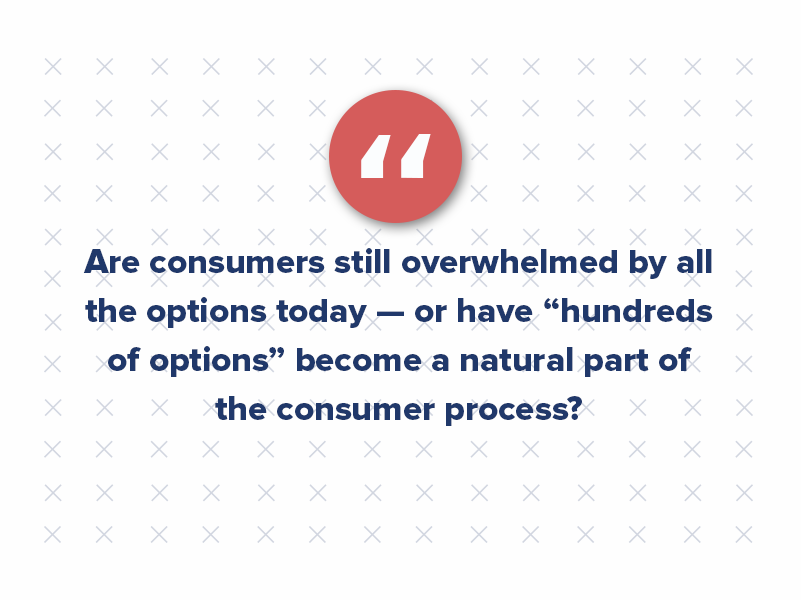
Yelp and Consumer Reviews
On any given day, you have hundreds of restaurant choices (overwhelming, right!?). However, today with sites like Yelp, you can capture the opinions of thousands of consumers in a single star rating (e.g., 4.5 out of 5 stars). Read in-depth reviews, see first-hand photos, and check the credibility of the reviewers. With hundreds of restaurant choices in your area, you can then sort and select them based on multiple criteria (e.g., ratings, cost, type of cuisine, etc.).
The “Yelp model” can be found in other forms (e.g., TripAdvisor) and on any retailer site. It helps us quickly sort through countless product options and make an informed consumer decision. Consumer review sites seem to make the Paradox of Choice much less daunting and, for some, quite enjoyable.
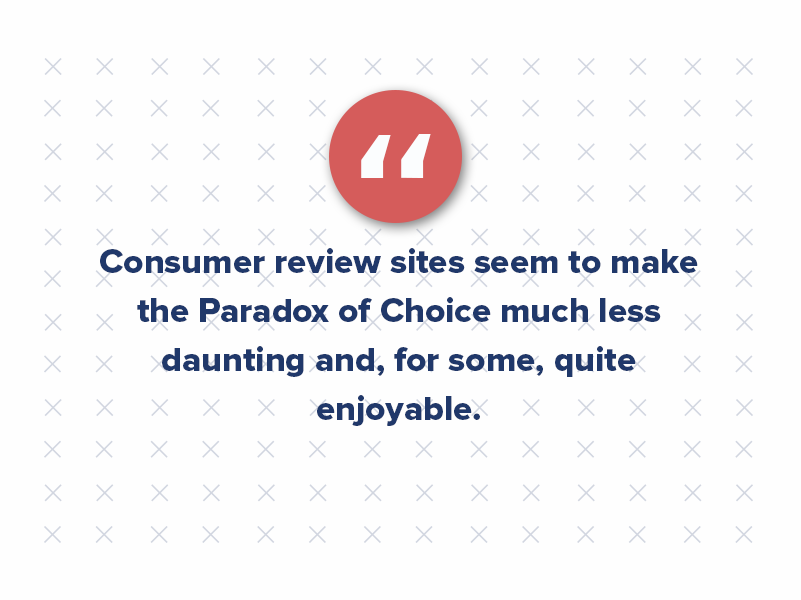
Contextual Advertising
With contextual advertising, consumers receive coupons and promotions based on their location. This advertising trend is quickly growing as our GPS location determines which digital ads might be relevant to us.
In theory, ads for nearby businesses can be pushed out to consumers as they get close. For example, a coupon for a local restaurant appears on my phone as I come within the vicinity. That restaurant, for the moment, becomes both top-of-mind and incentivized. As contextual advertising becomes more prevalent, consumers will be served relevant options without even seeking them out.
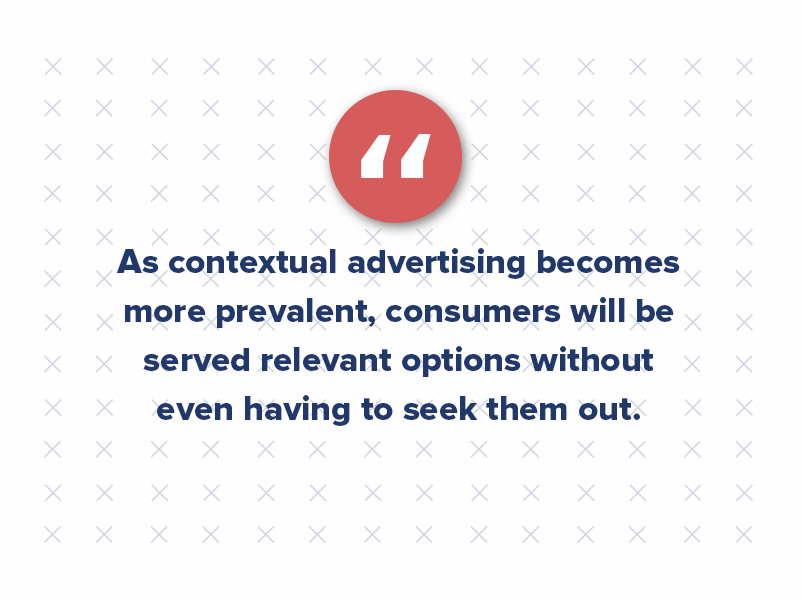
Equally impressive, geo-tracking also filters search results according to your location. Google’s Shopping tab notes nearby stores and their distances for your items. A hundred places may have your items, but most of us will only consider buying at the stores closer by. We narrow our choices depending on proximity, and geo-tracking helps us do that.
How It Impacts Apartment Marketing
How does the Paradox of Choice impact the multifamily housing market? With so many options available, it can be overwhelming for renters to choose where they want to live. The Paradox of Choice makes it difficult for renters to decide where they want to live and can lead to them becoming disengaged and uninterested in the options available to them. This presents a problem for apartment marketing, creative advertising, and brand development.
To overcome this challenge, creative advertising and brand development in the apartment market must focus on simplifying the decision-making process for consumers. This can be achieved through effective messaging and branding that emphasizes the unique selling points and benefits of each community or building. By highlighting what sets a particular community or building apart from the competition, it can help consumers to see the value in choosing that option.
Additionally, apartment marketing should aim to create an emotional connection with consumers. Using compelling images, stories, and testimonials can humanize the experience of living in a particular community or building. Connecting with residents emotionally can help overcome the confusion and indecision caused by the Paradox of Choice.
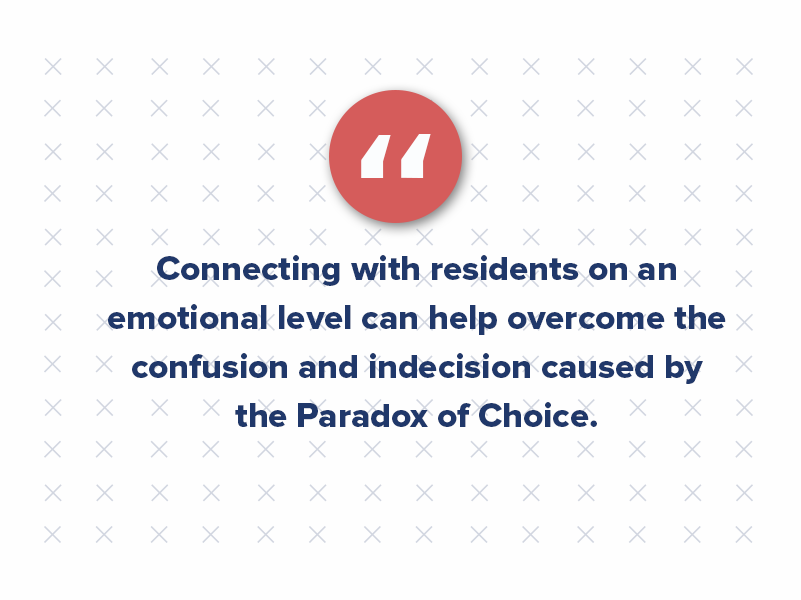
Finally, apartment marketing must be flexible and adaptive to changing market conditions to remain relevant and effective. This can be achieved through ongoing research, market analysis, and developing new apartment marketing strategies and tactics.
Is the Paradox of Choice a Hindrance or a Benefit for Multifamily?
While the Paradox of Choice may seem to hinder the multifamily market, it can also have several benefits. Firstly, it creates healthy competition among communities and buildings. With more options available, communities and buildings must work harder to stand out from the competition and offer something truly unique to attract renters. This can lead to better amenities, more creative apartment marketing strategies, and a better living experience for renters.
Additionally, the Paradox of Choice pushes the line of creative advertising in the multifamily market. To stand out from the competition, communities, and buildings must develop new and innovative ways to market themselves to renters. This can result in more creative and engaging advertising campaigns, which can more effectively capture potential renters’ attention.
Finally, the Paradox of Choice offers renters more choices in where they want to live. Renters are no longer limited to a few communities or buildings in their area; they can now choose from various options. This allows renters to find a community or building that truly fits their needs and lifestyle, leading to a higher satisfaction level and a better living experience.
Answering the Big Question
Is the Paradox of Choice still valid with the tools that the internet has enabled? Is having more choices making us more anxious? In the realm of consumer products, we don’t think so. Yes, we have more choices, but we are better at sorting through it all. Ratings, reviews, geo-track: It helps us find the diamond among the rocks of products and services. With so many tools accessible at the click of a button and tap of a finger, more choices mean no problem!


